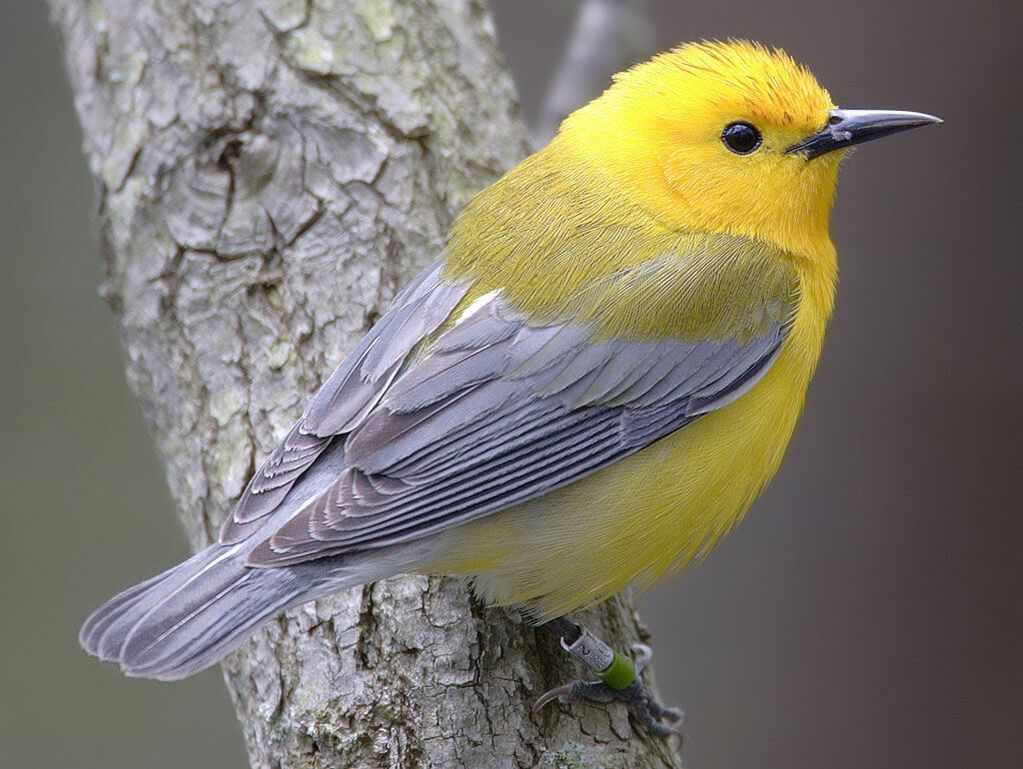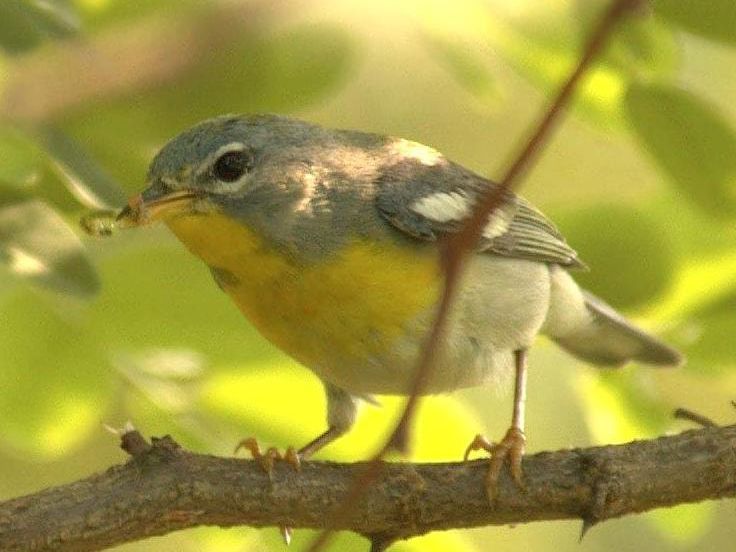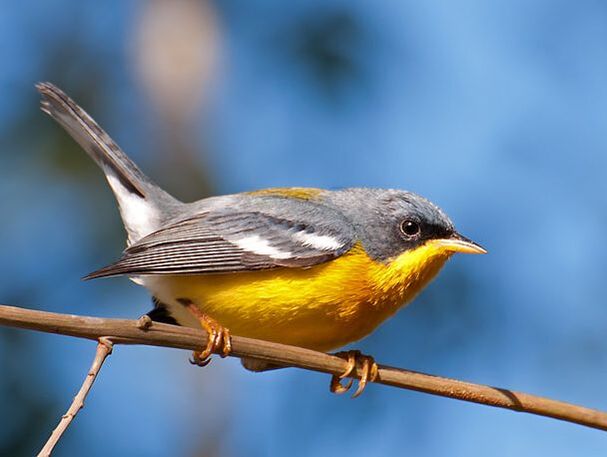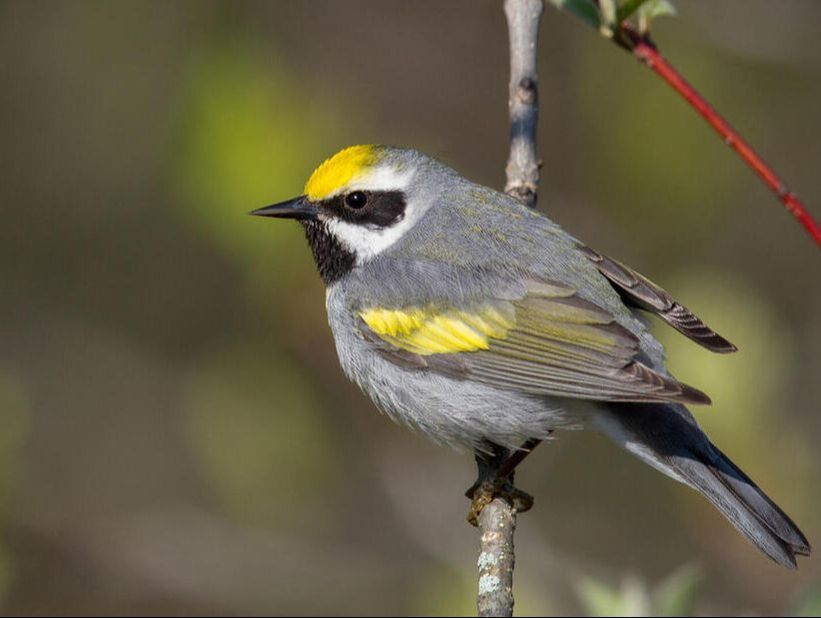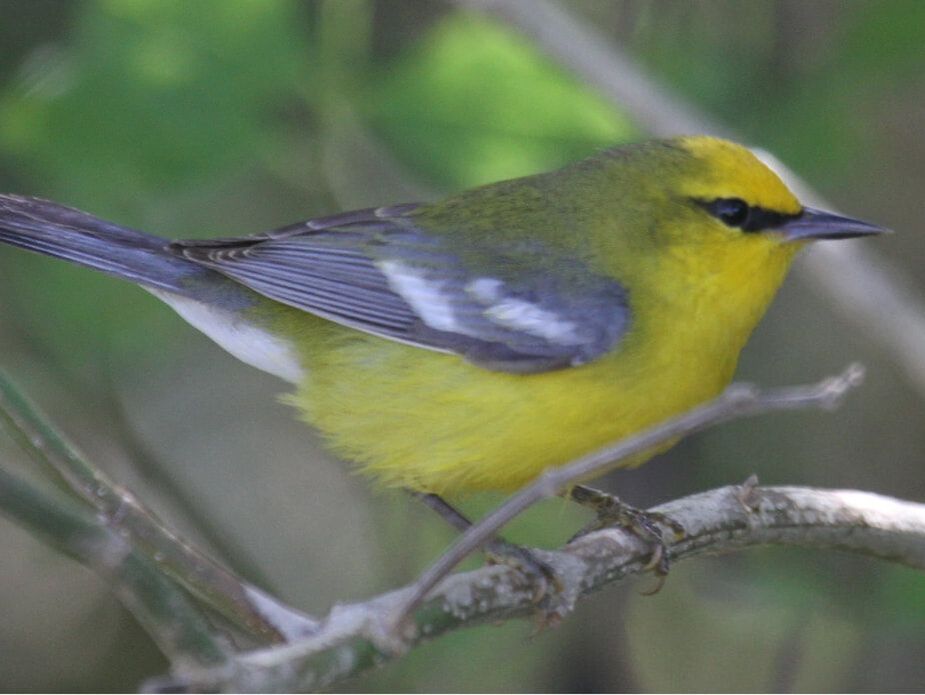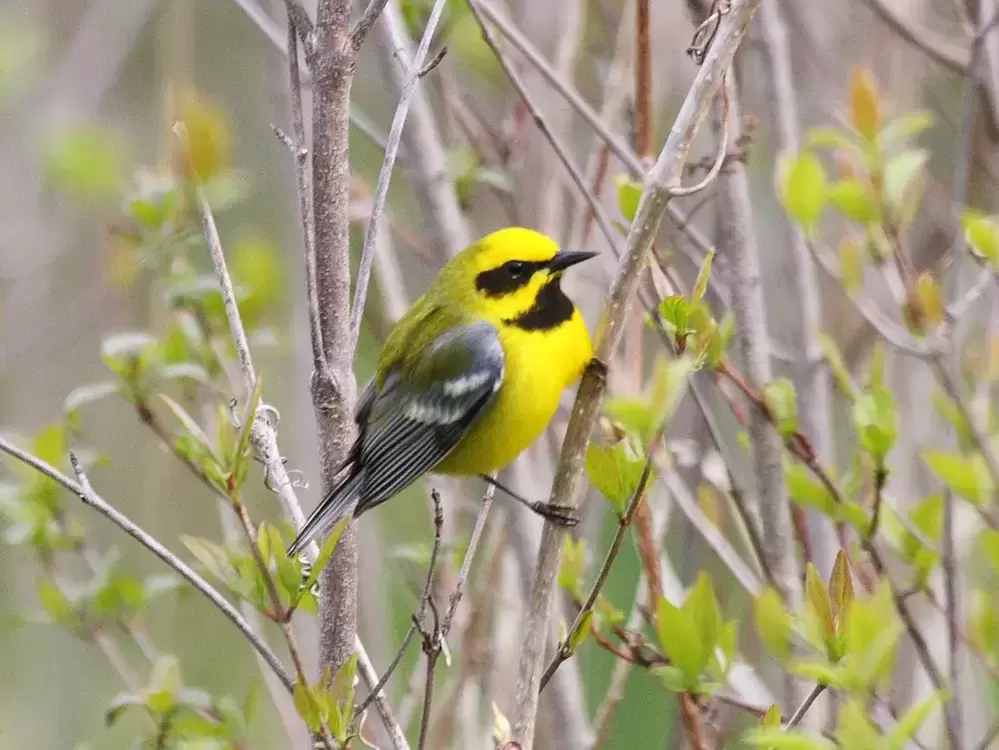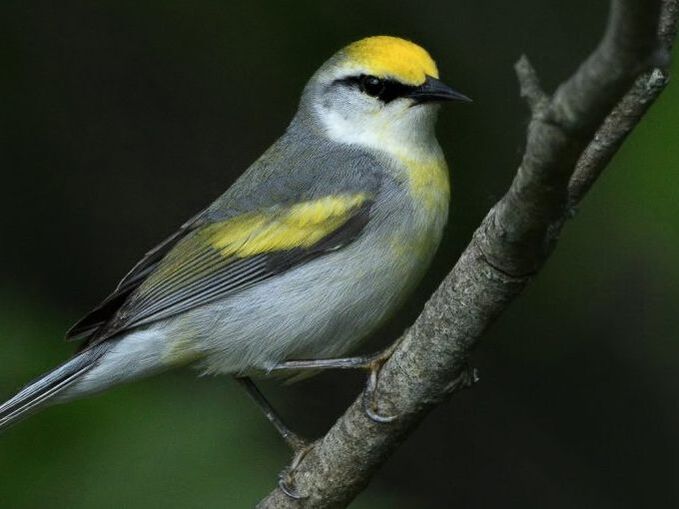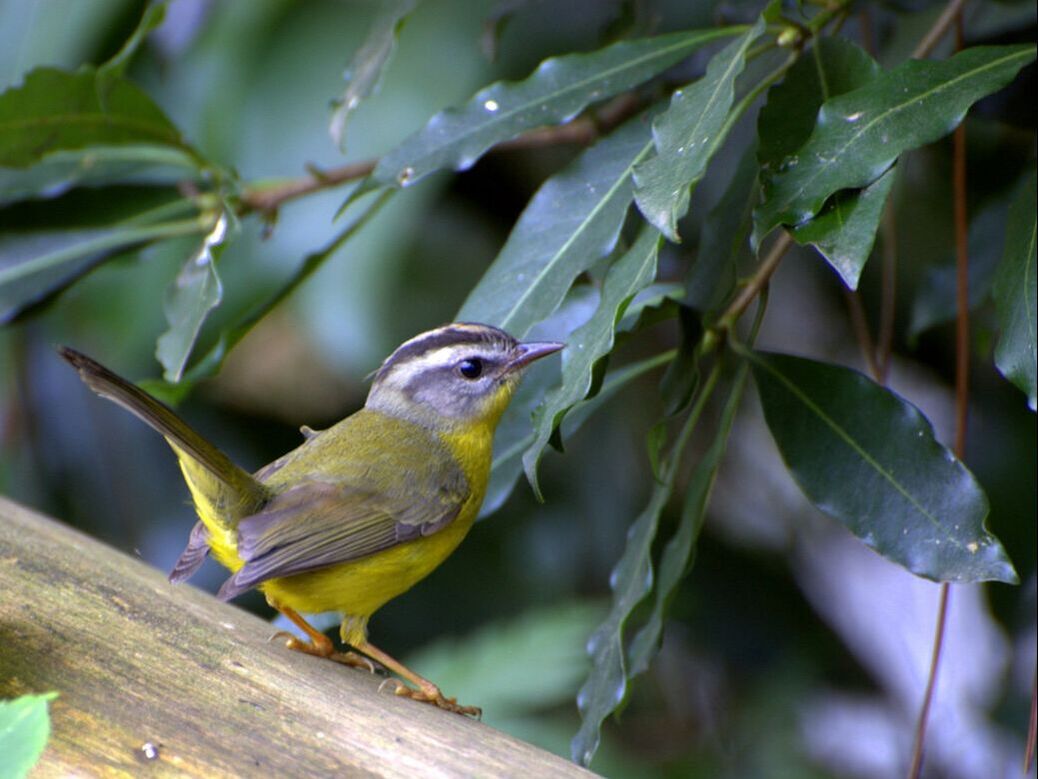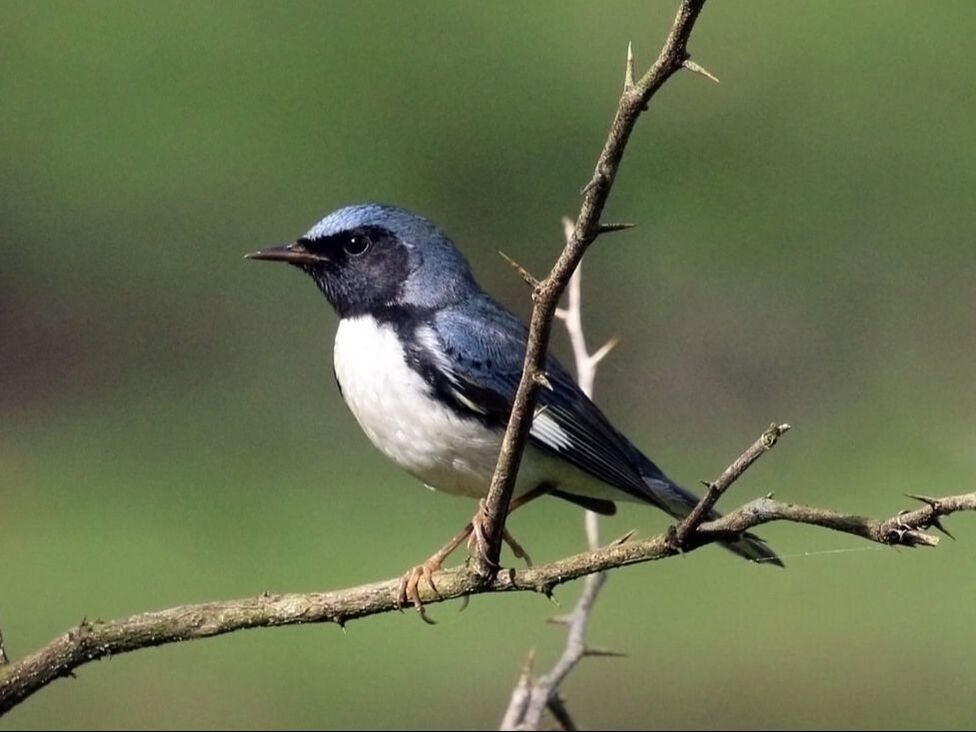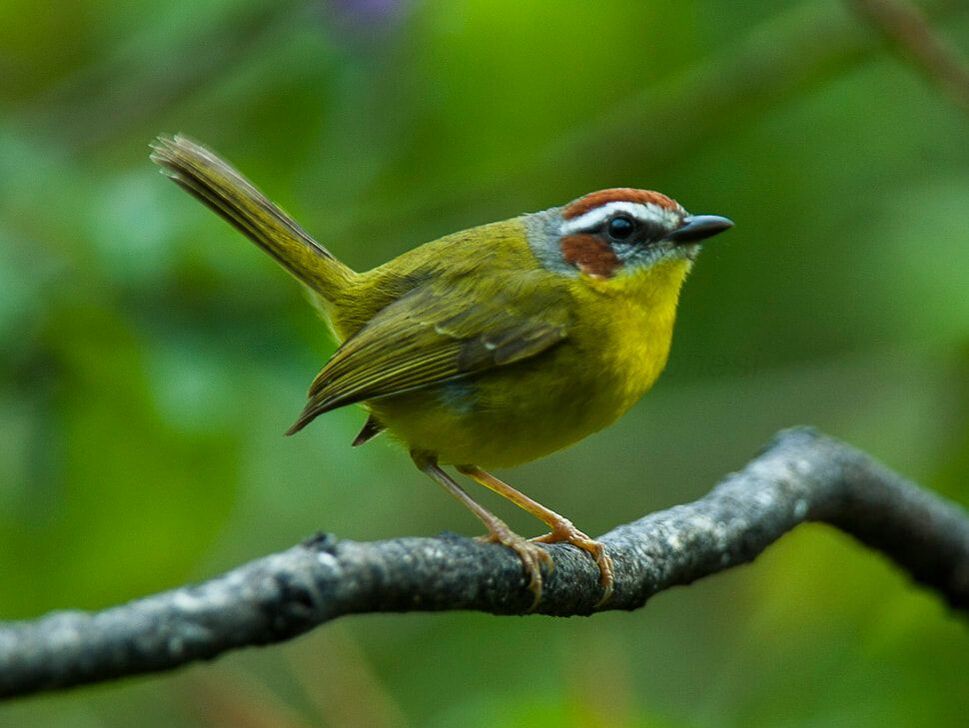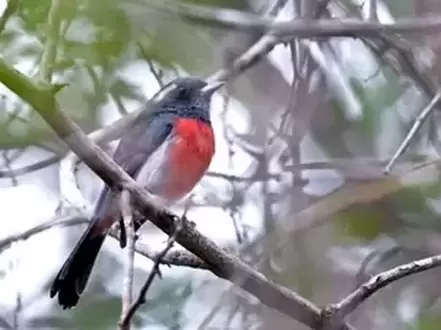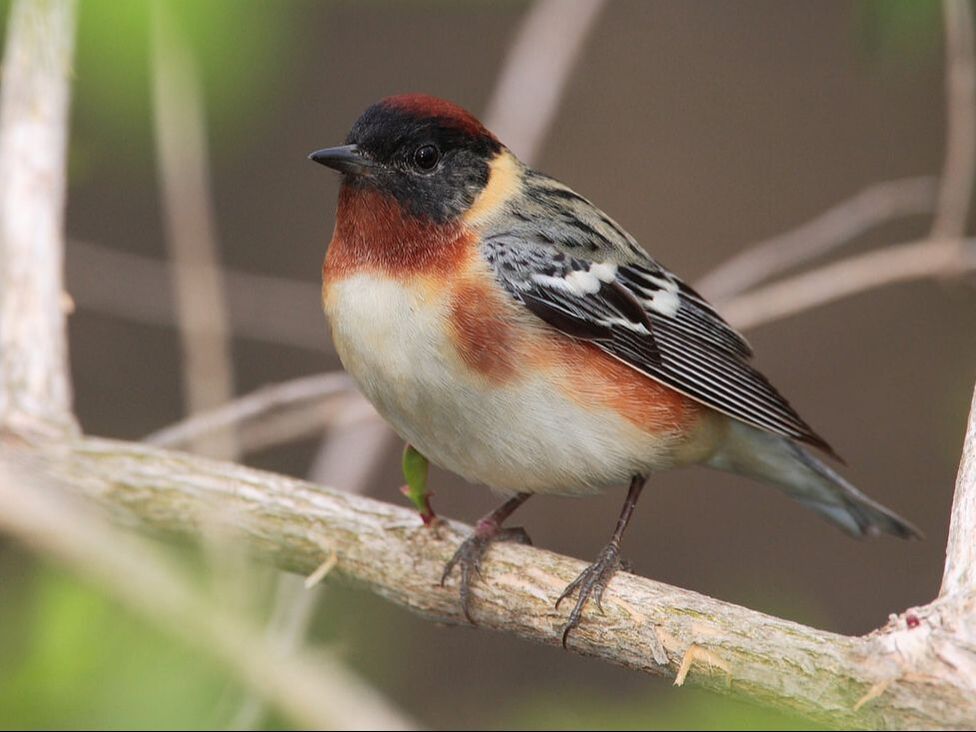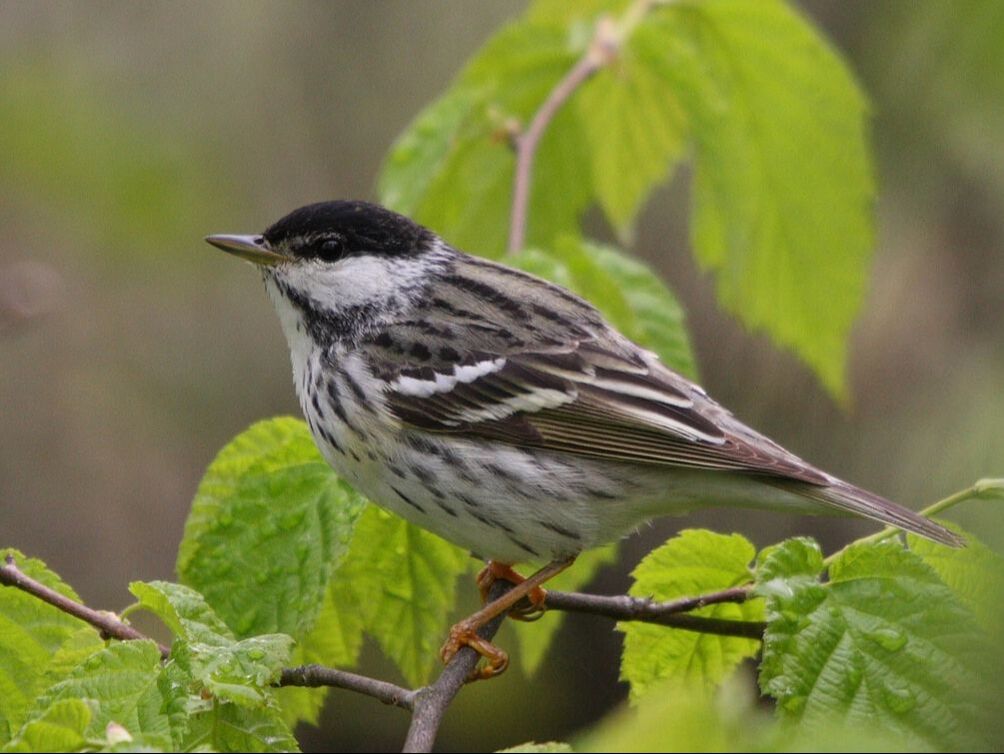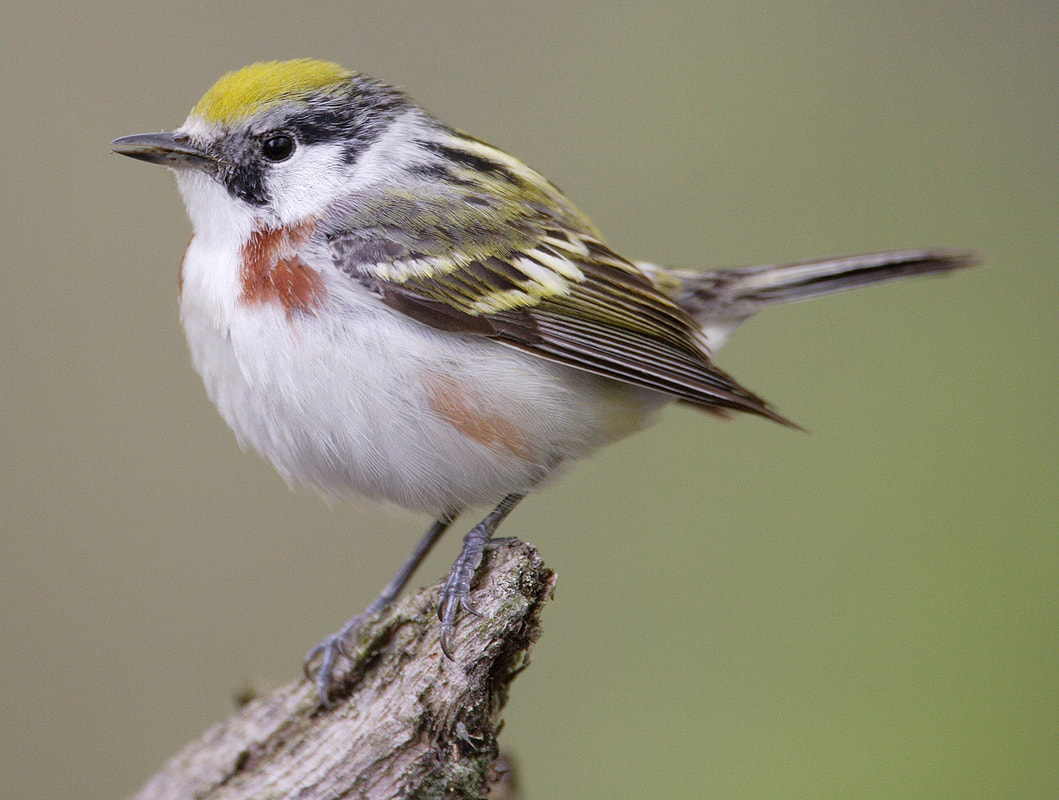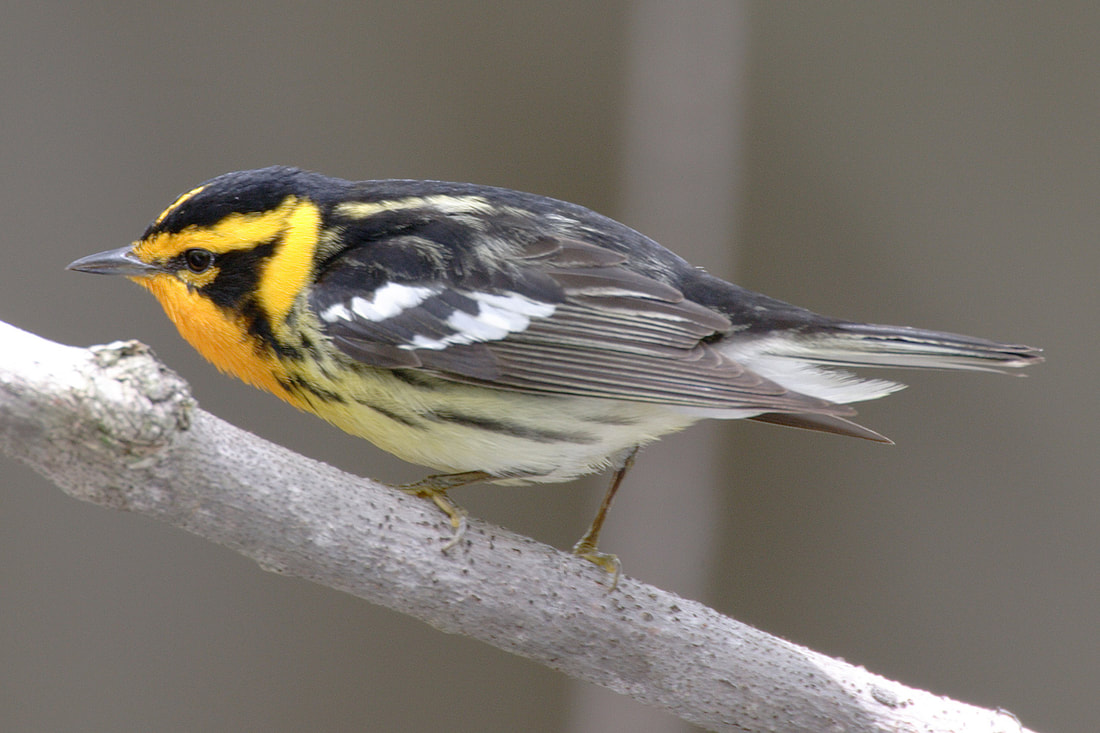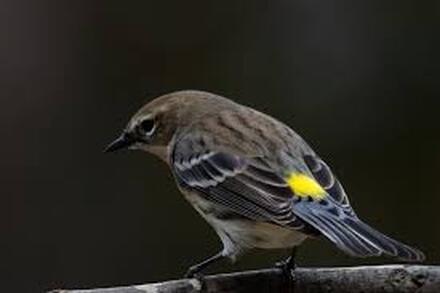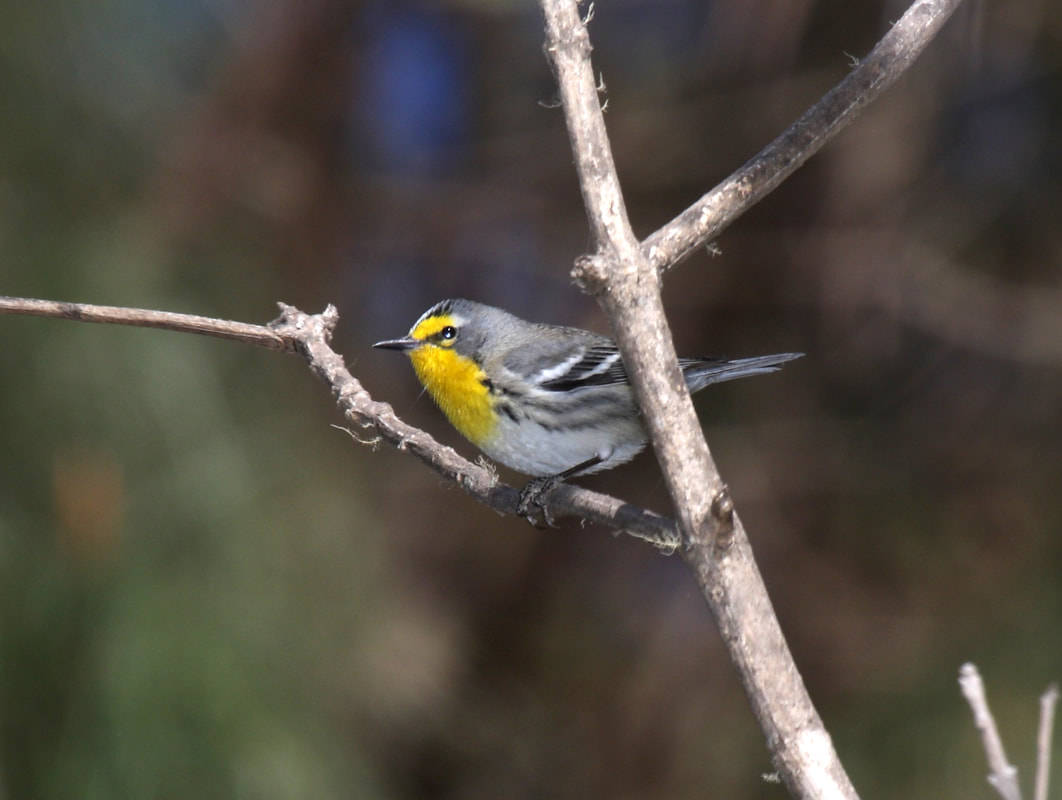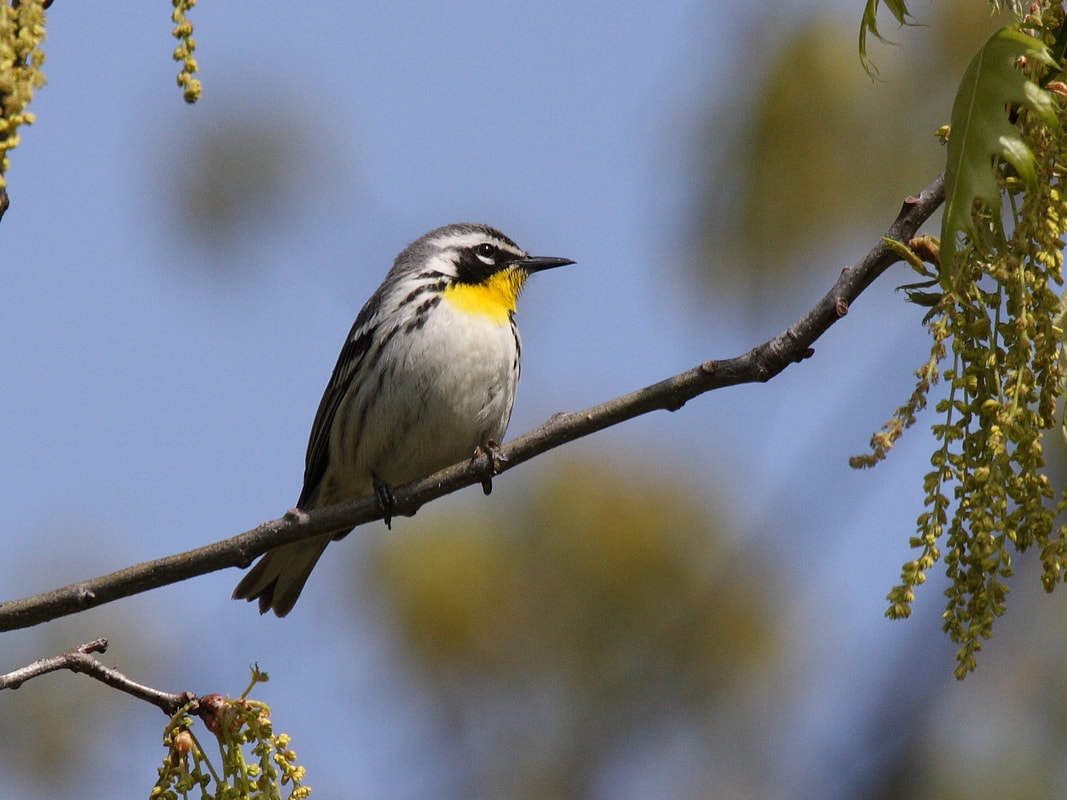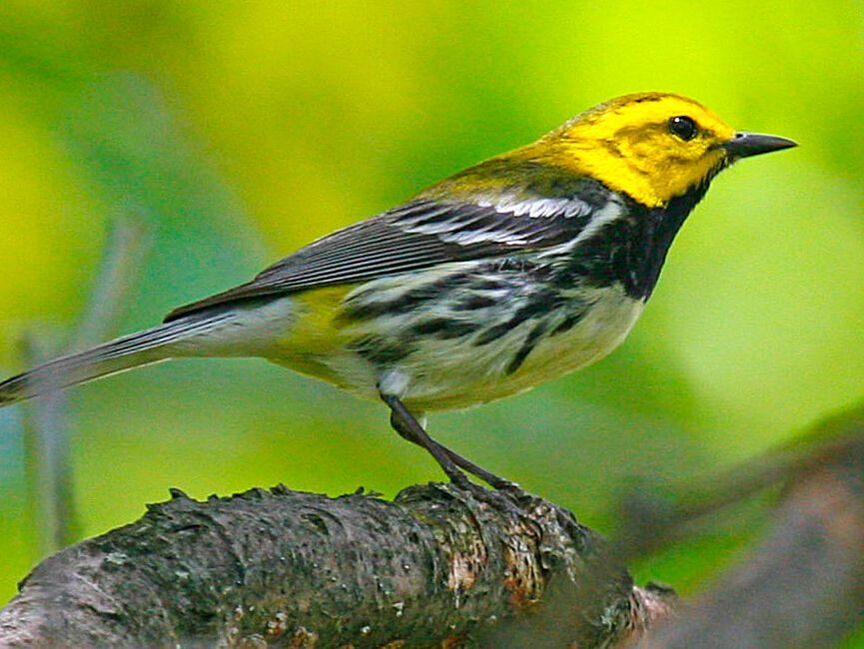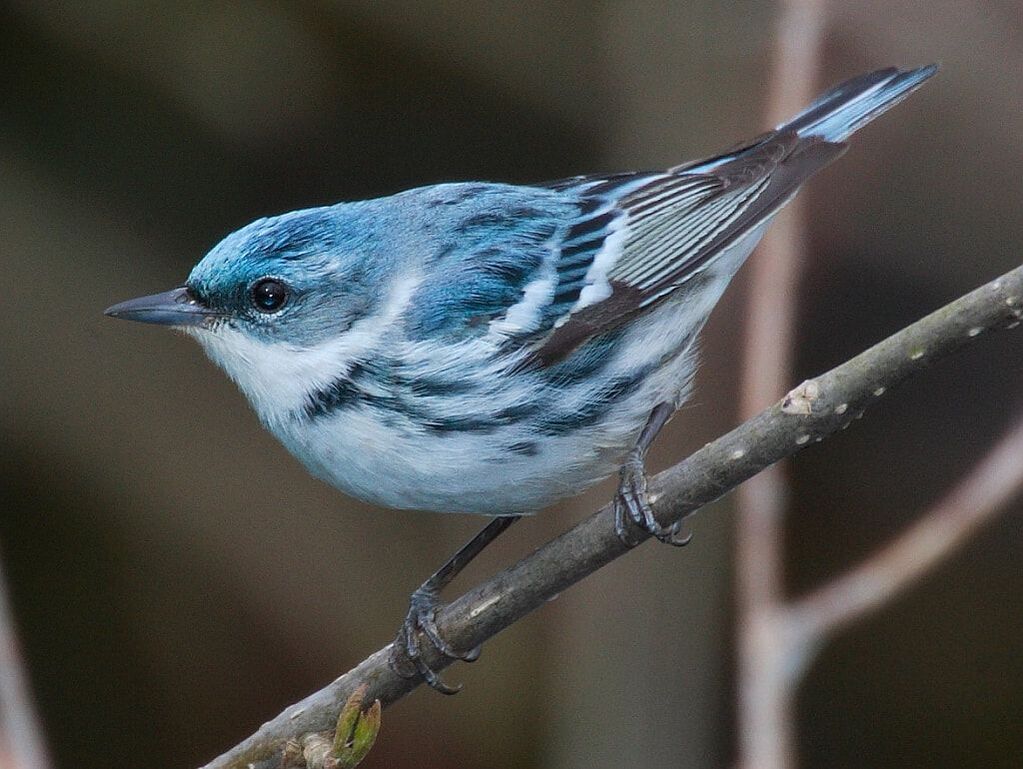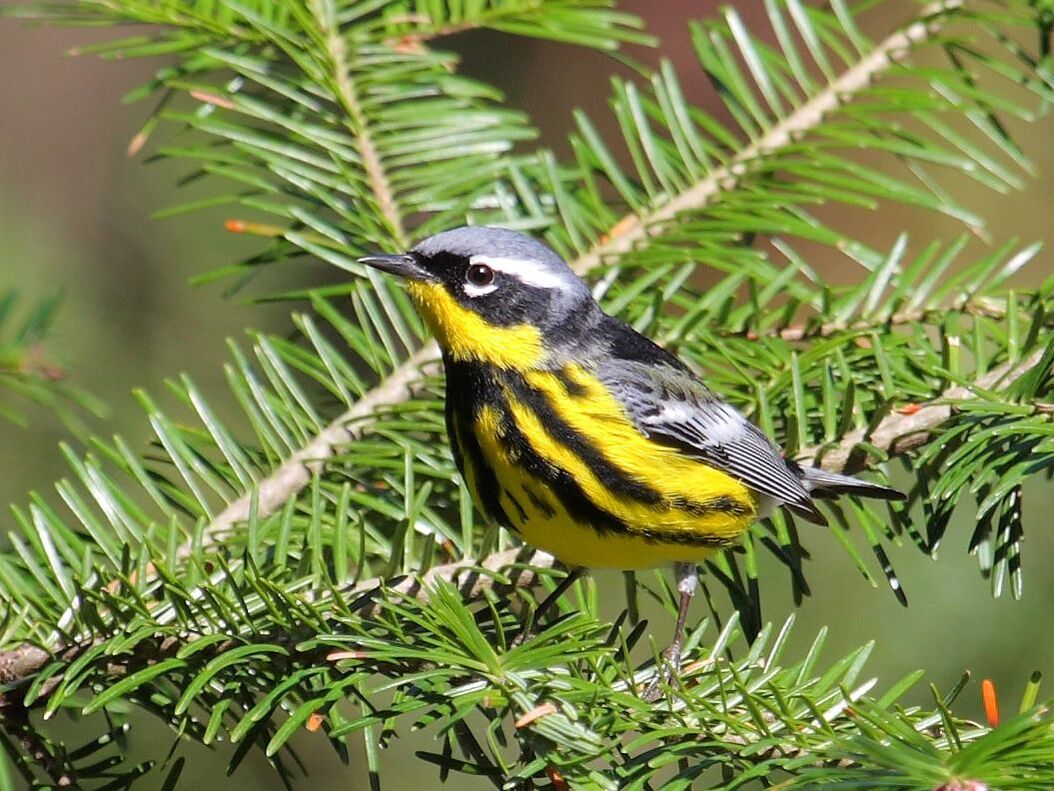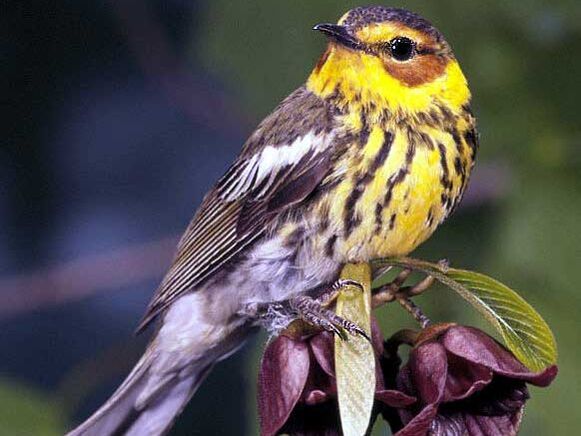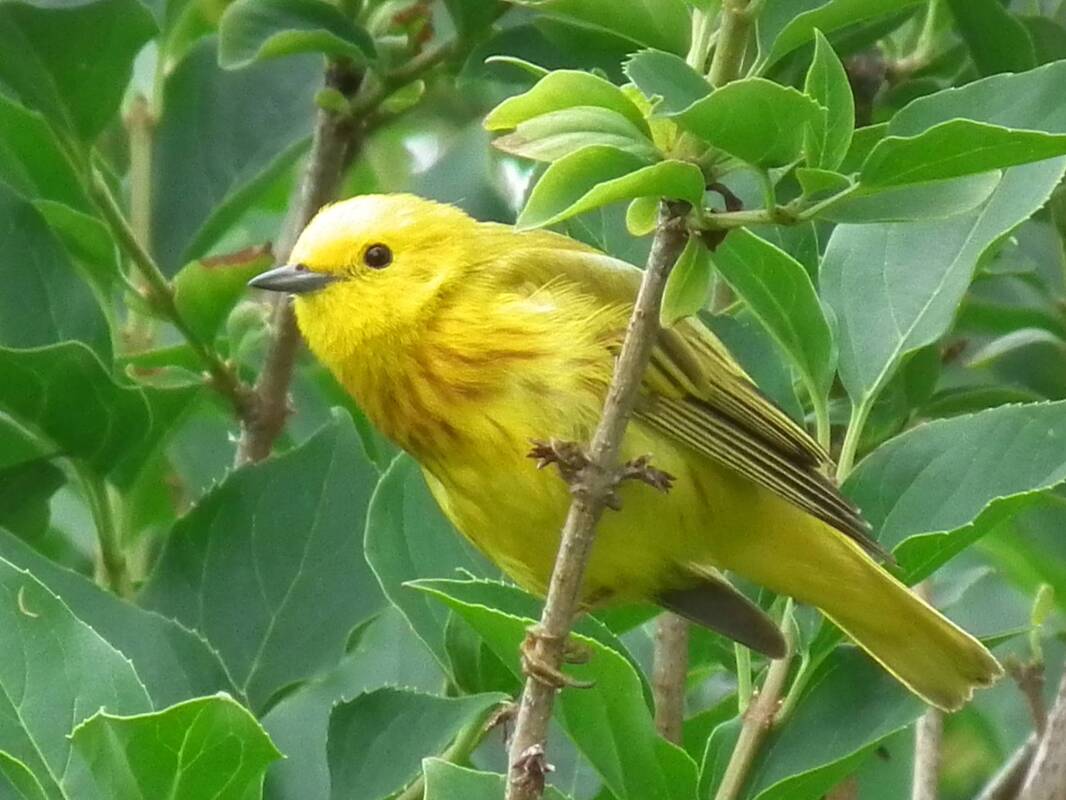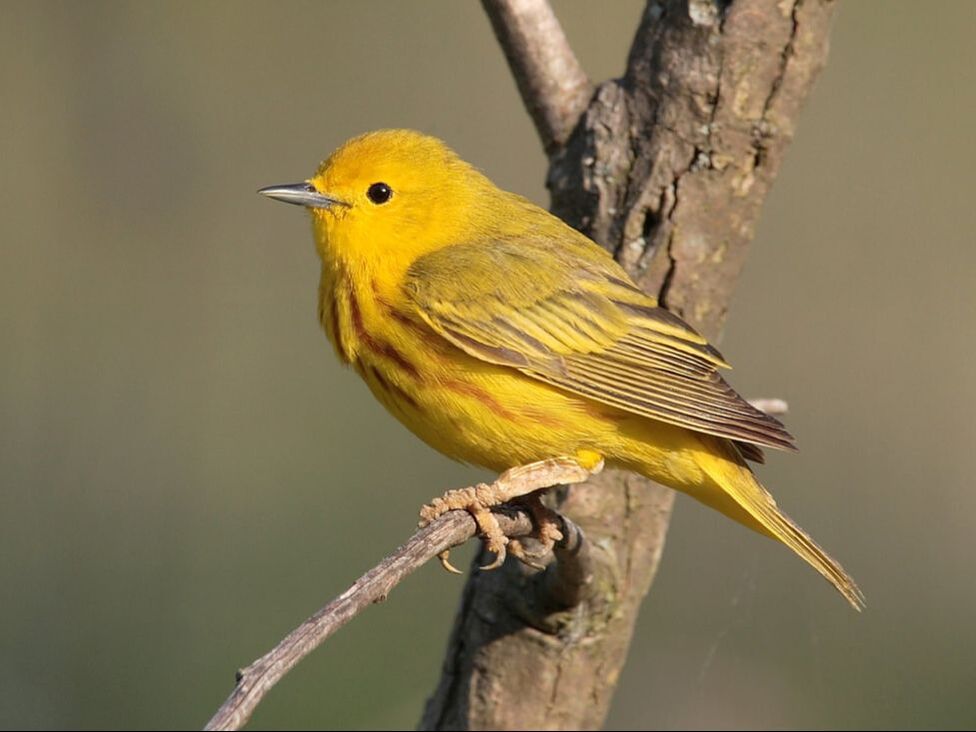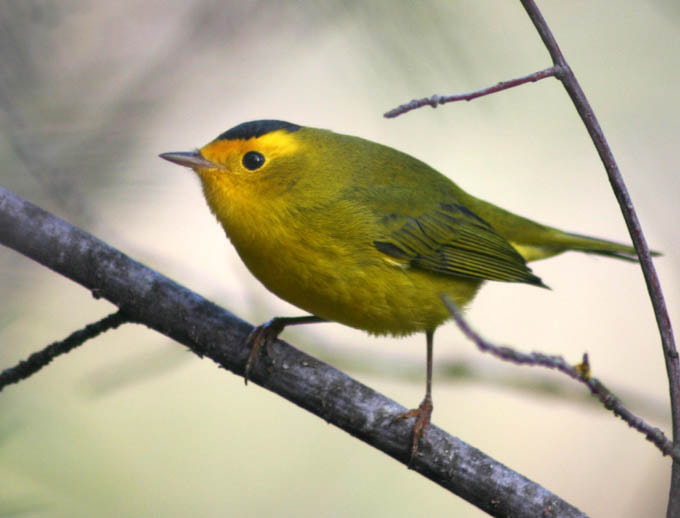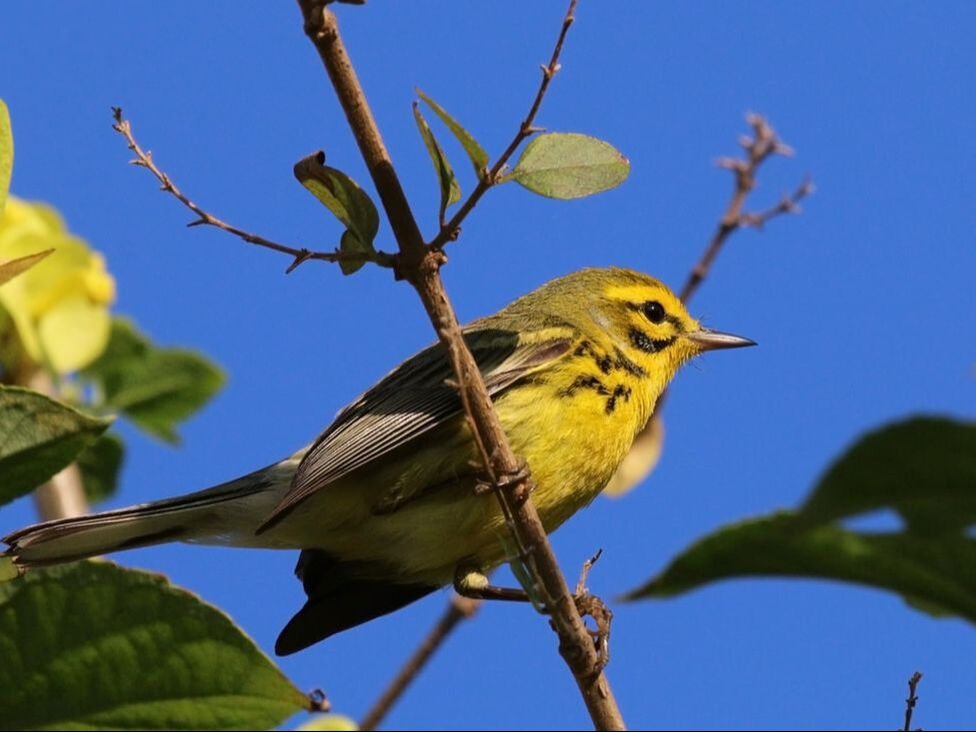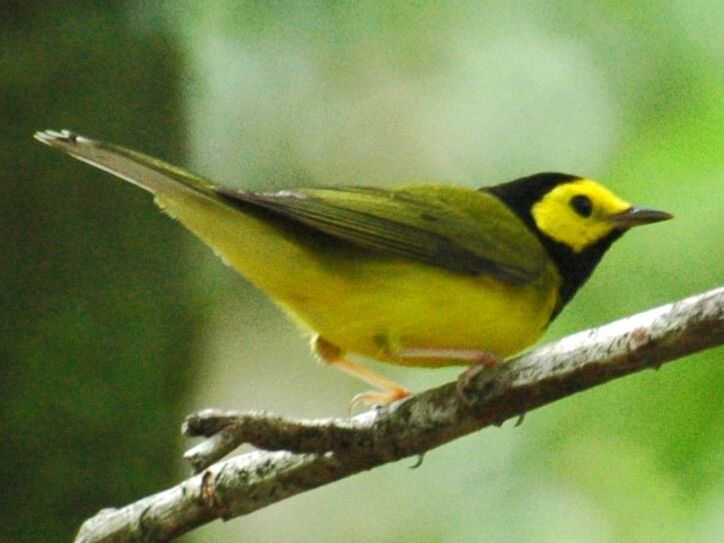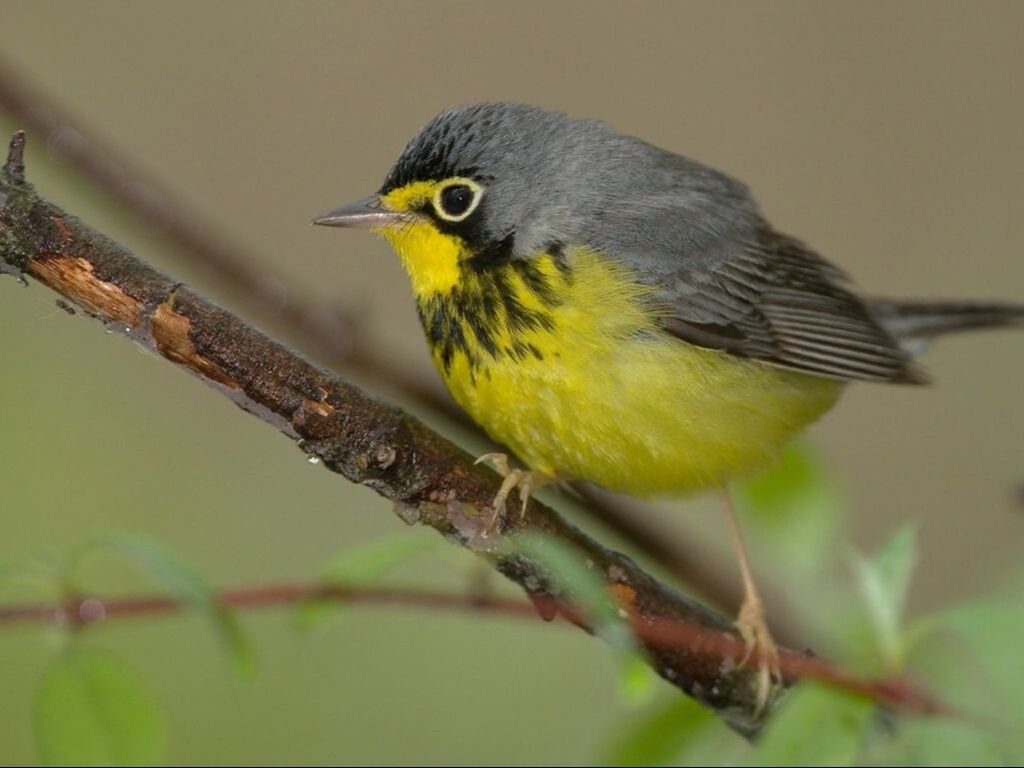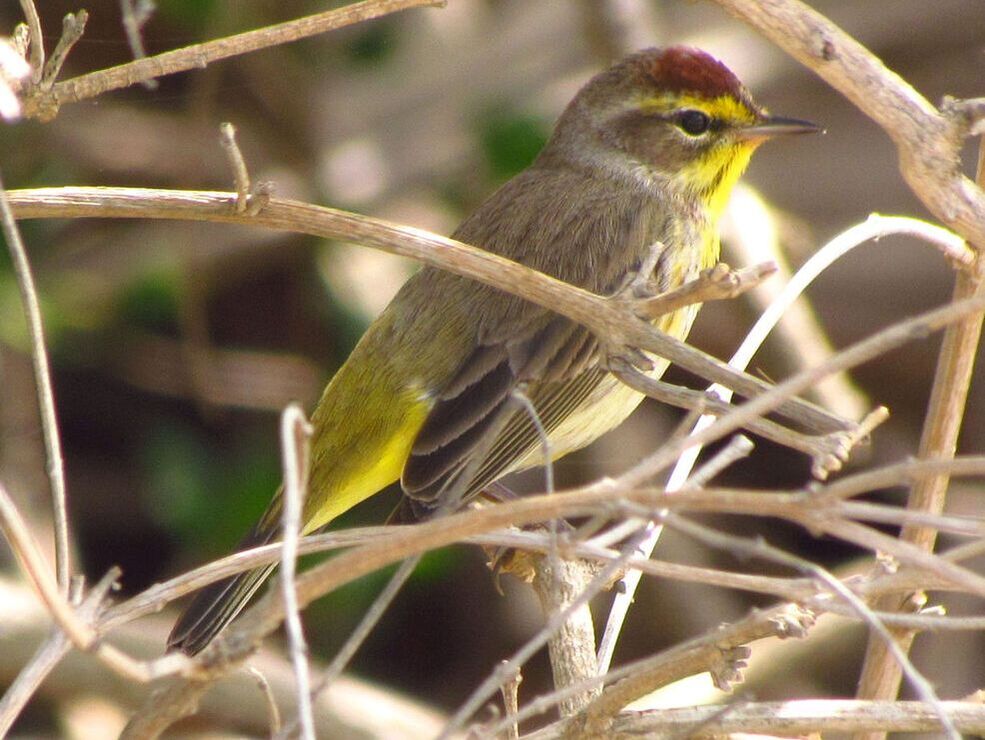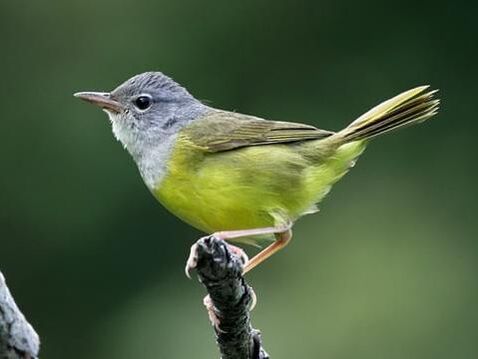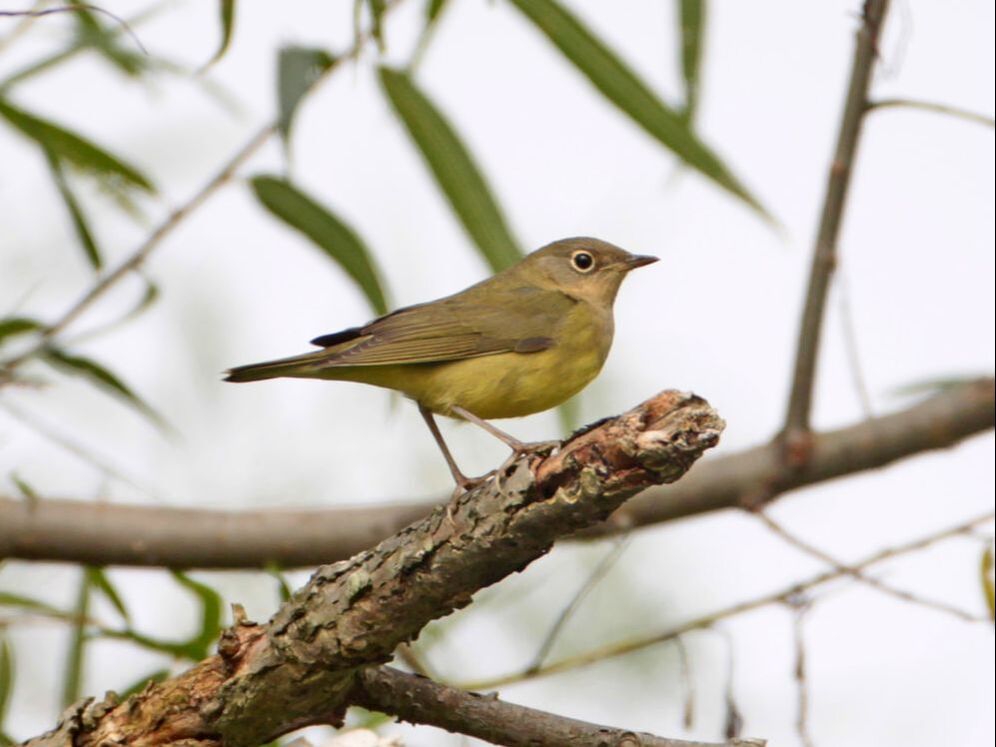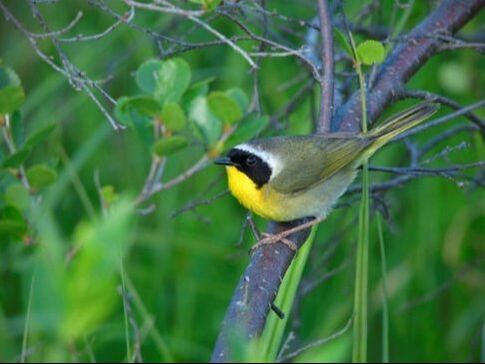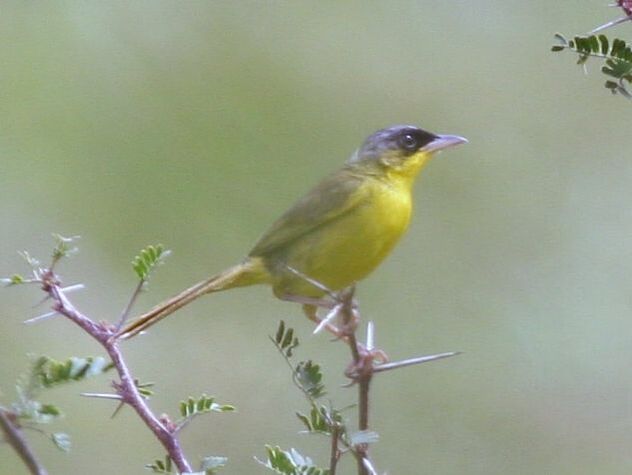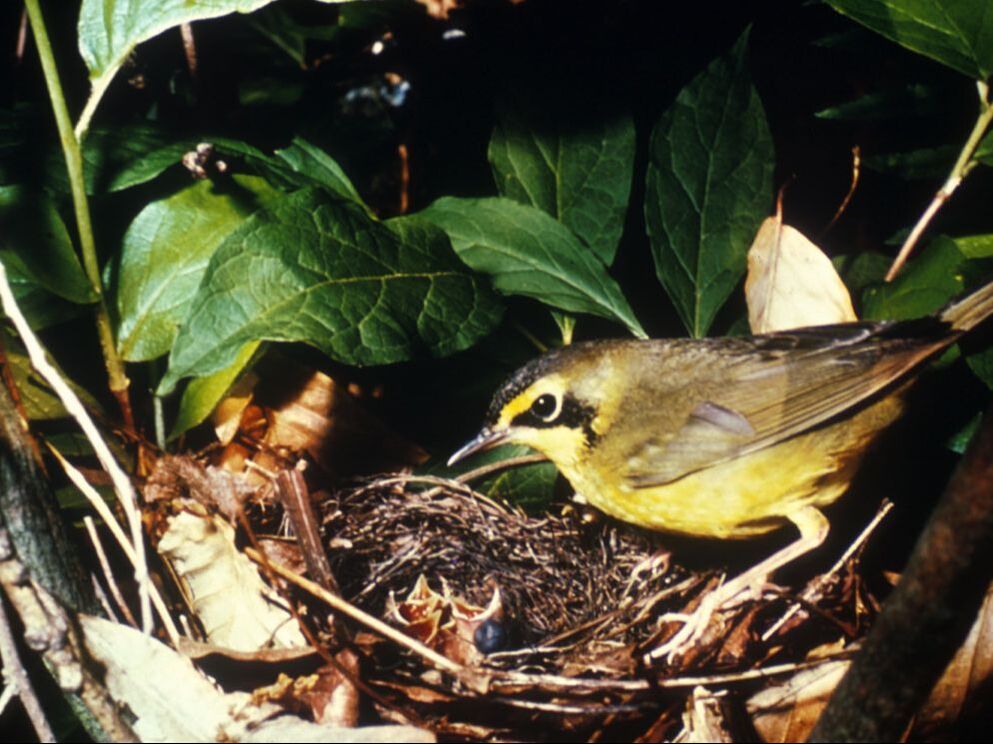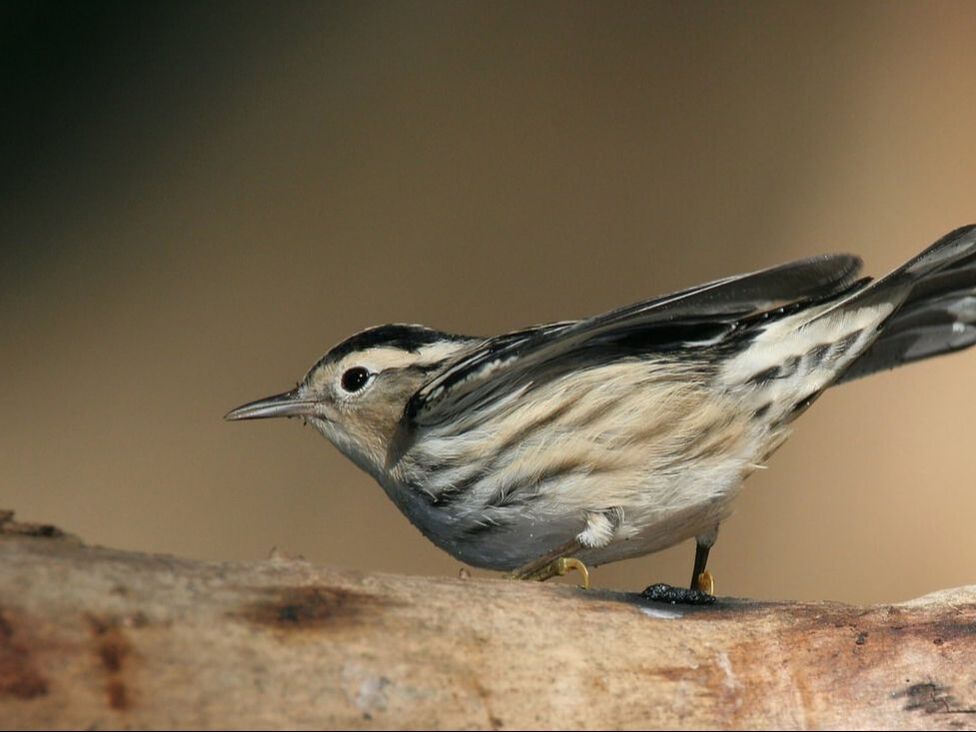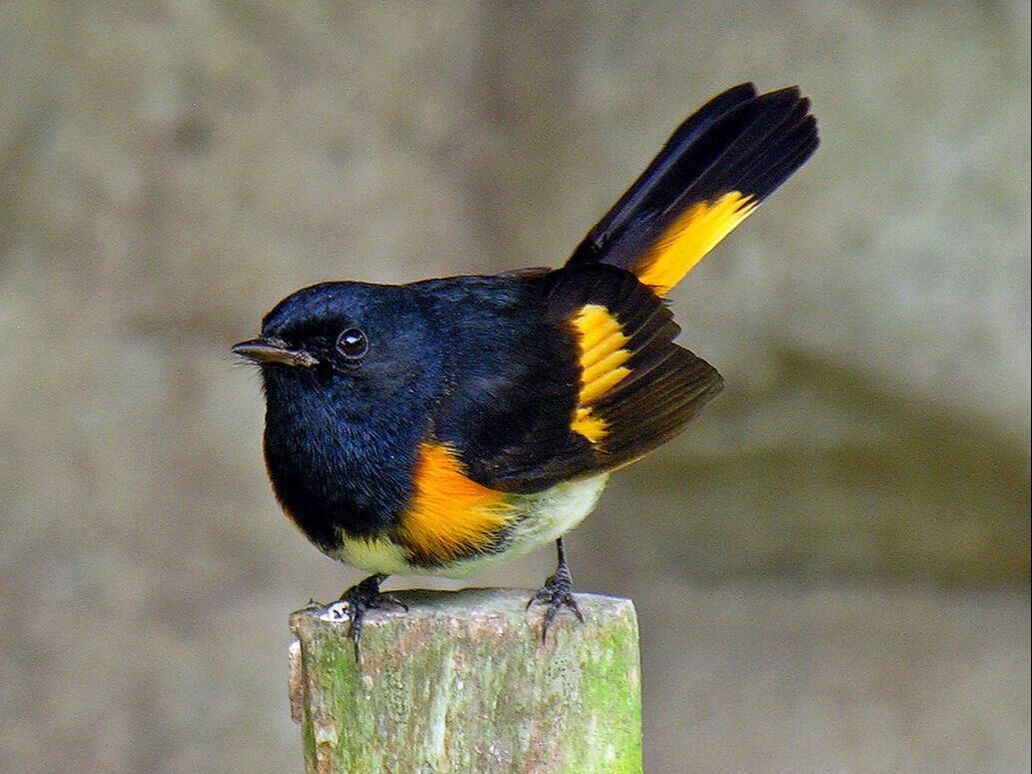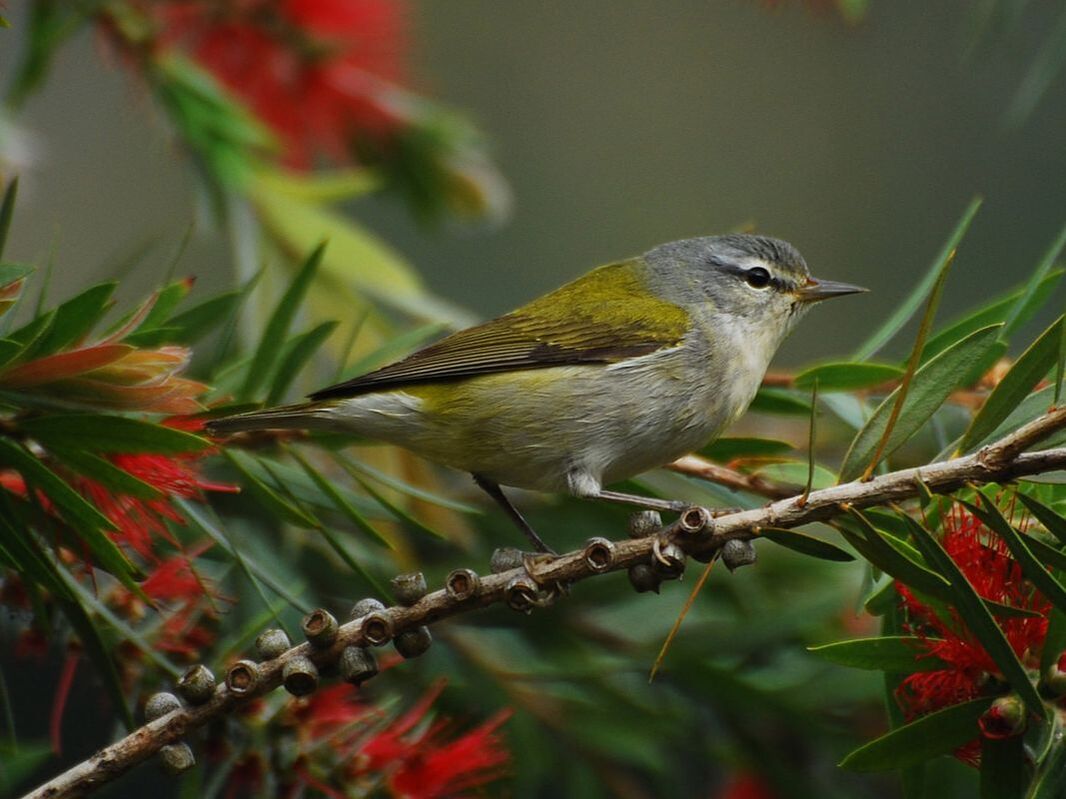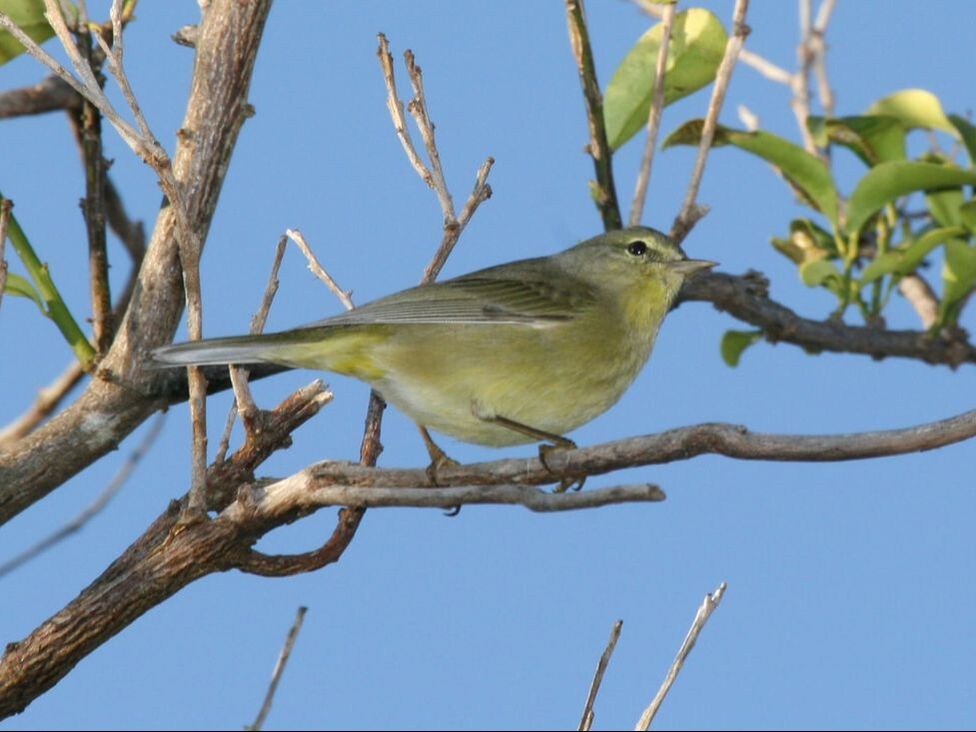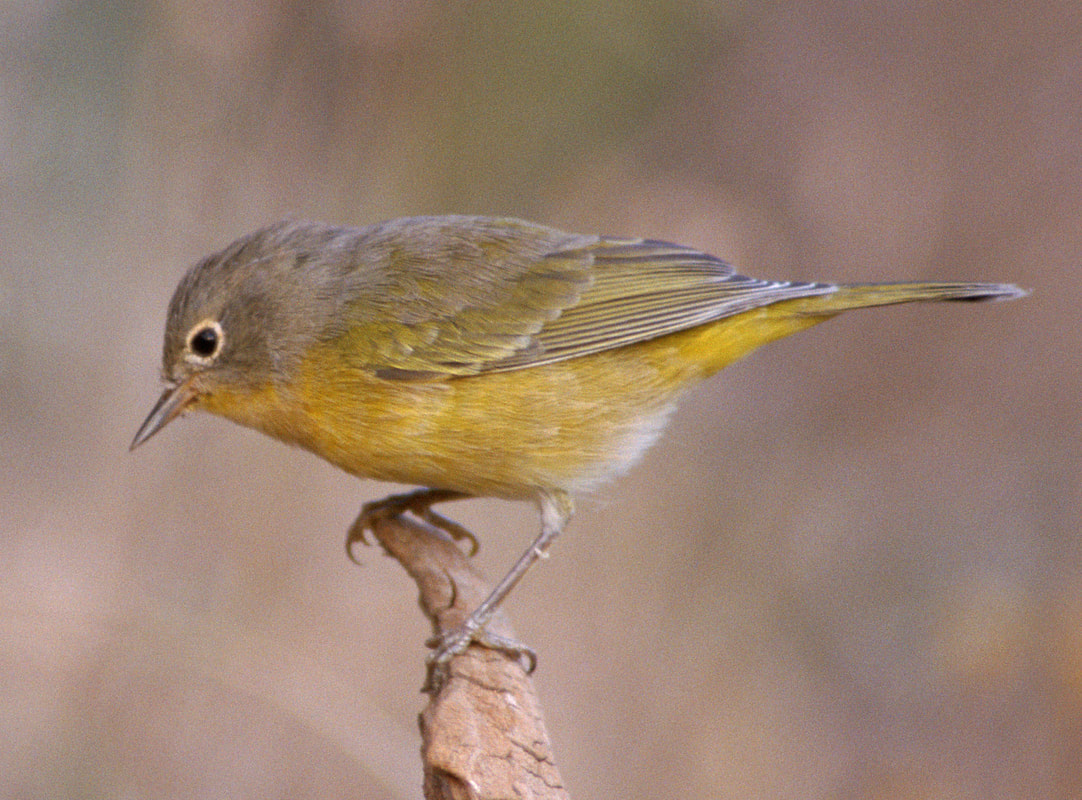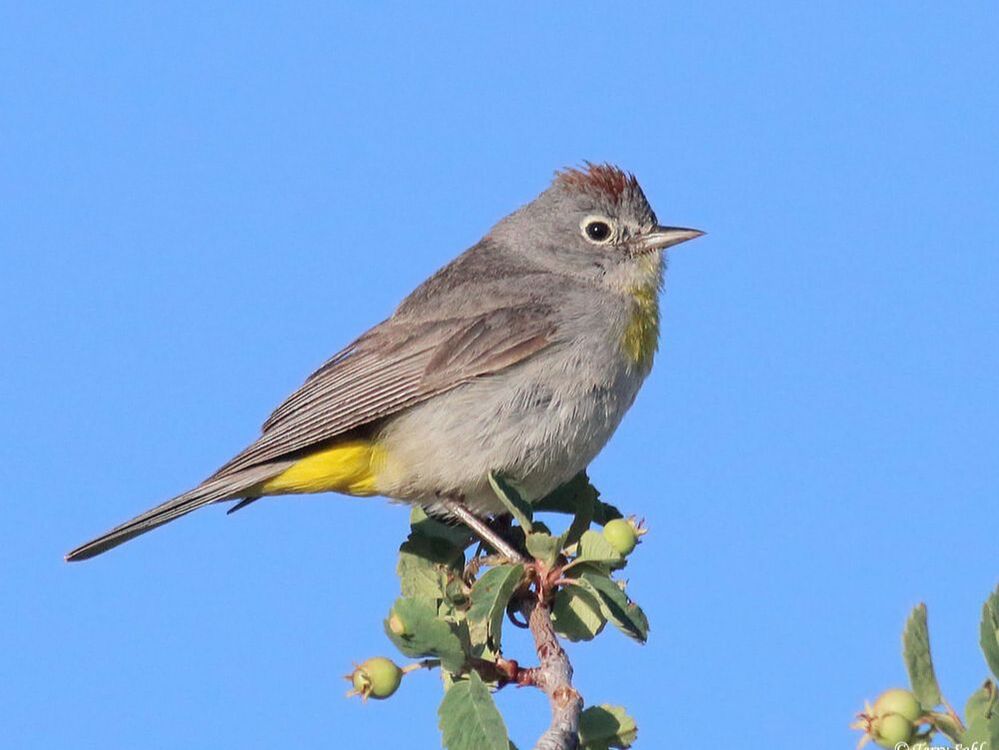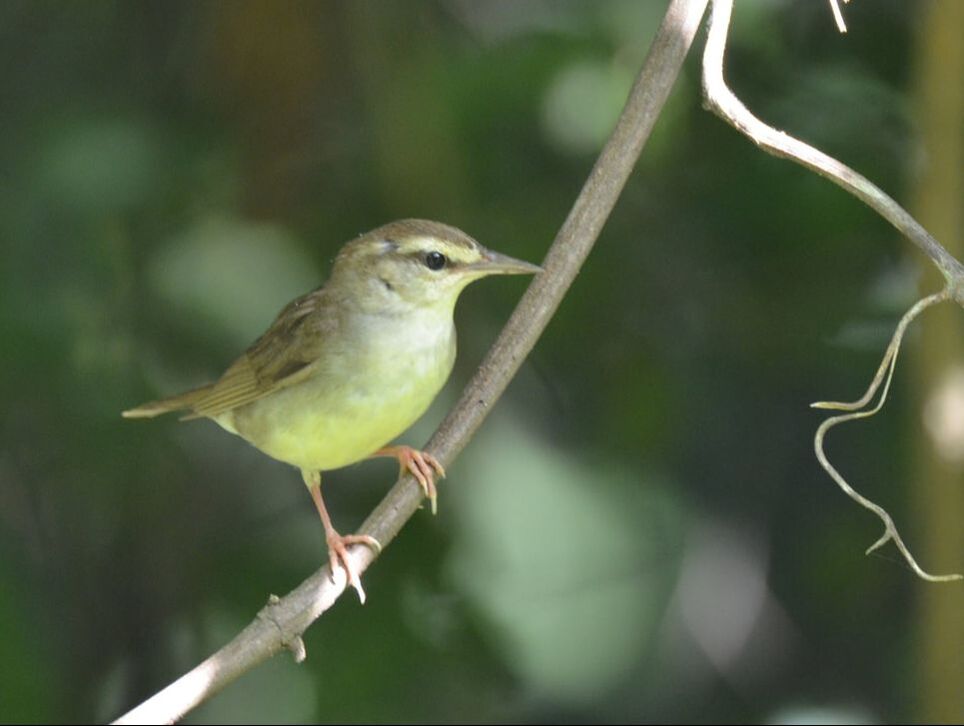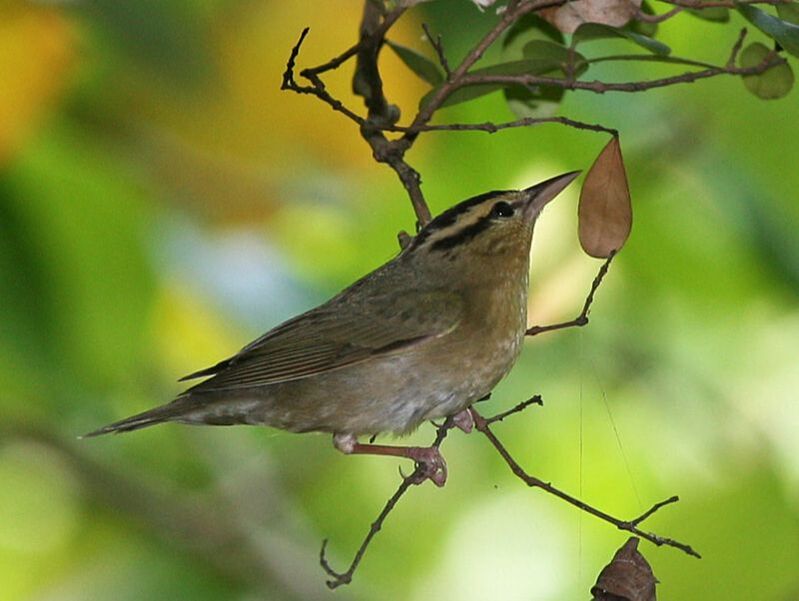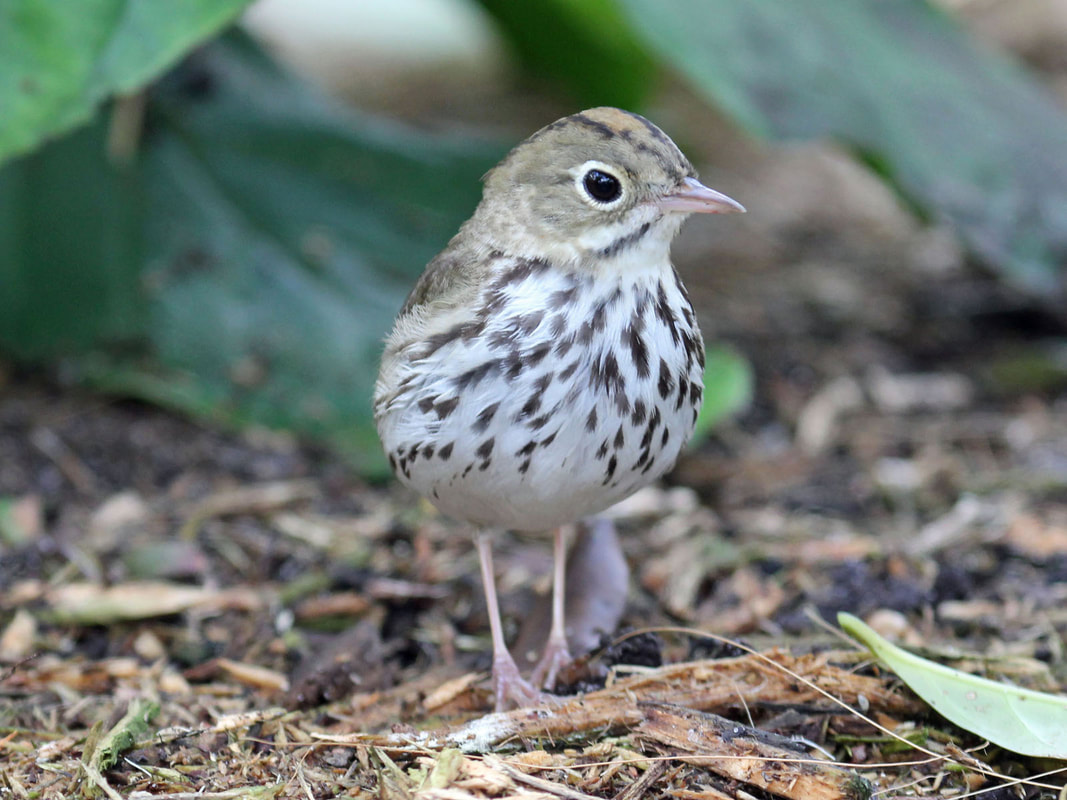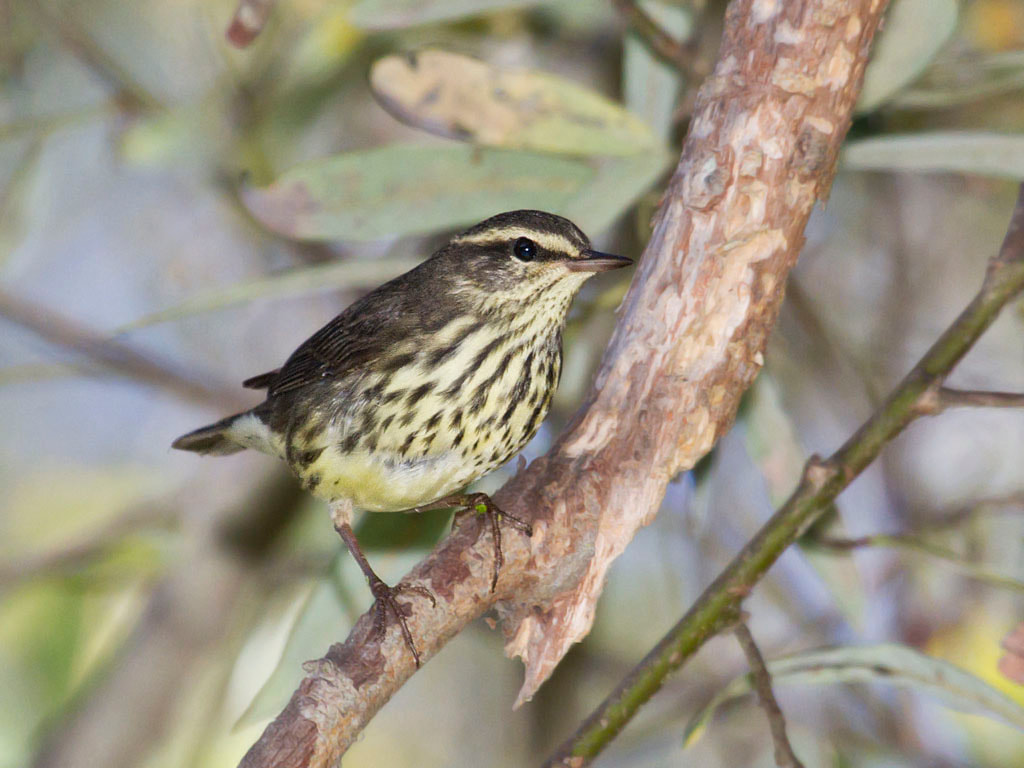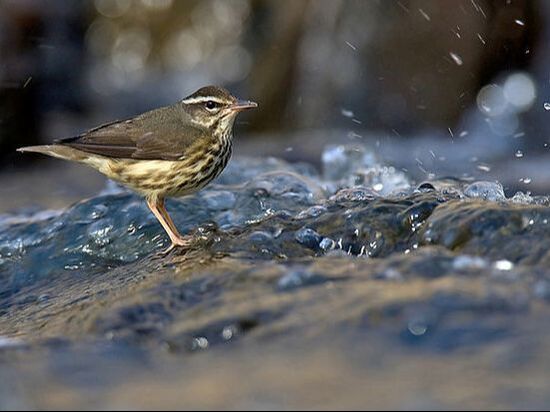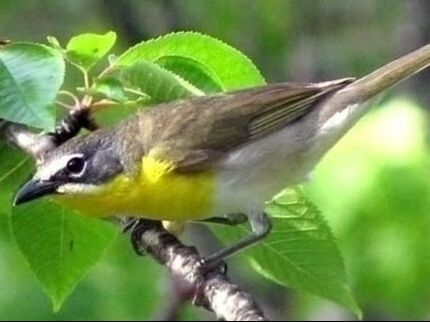Warblers - in Belize
Prothonotary Warbler
Prothonotary Warbler - Shockingly bright warbler of swamps and wet forest. Males have gorgeous yellow head and underparts with greenish back and blue-gray wings. White undertail coverts. Females and immatures slightly duller than males. Sings a loud, piercing series of 6–10 high-pitched "tsweet" notes. One of only two warblers that nests in cavities.
BELIZE HABITAT - Low levels within swamp forest, river and stream edge, mangrove forest. Where can you find this bird in Belize? Common autumn and uncommon spring transient, mostly in coastal areas and cayes, late July to early November and early March to late April; occasional in winter. |
Northern Parula
Northern Parula - One of the smallest warblers; look for short tail and sharply pointed, bicolored bill. Bluish-gray above with distinctive lime-green patch on the back, white wingbars and eye-arcs, yellow on throat, and white belly. Found in forested areas; has a fondness for nesting in Spanish moss in the southeastern U.S. Loud song is buzzy, ascending trill with sharp chip at the end; sounds like a zipper. Winters mainly in Mexico and Caribbean.
BELIZE HABITAT - Mid-levels to canopy ; forest interior and edge, tall second growth scrub. Where can you find this bird in Belize? Fairly common to common winter visitor on cayes and north east mainland, late August to early May, becoming less common south to north Cayo and south Stann Creek; scarce on mainland farther south. |
Tropical Parula
Tropical Parula - Small short-tailed warbler; bright and boldly patterned. Blue-gray above with green back, two bold white wingbars (limited white in Middle American birds), and yellow-orange throat and chest. Males have darker face and brighter yellow-orange chest than females. Bill is sharp, black above and yellow below. Very similar to Northern Parula; note lack of white eyearcs and no dark markings on breast. Beware of rarely-occurring hybrids and some dull immatures, which can be very similar to Northern Parula. Common and widespread in forests throughout Central and South America; rare in U.S.; found only in mossy forests in southern Texas.
BELIZE HABITAT - Canopy and sub-canopy; broadleaf forest interior and edge. Where can you find this bird in Belize? Locally fairly common at middle and higher elevations in south Maya Mountains of Toledo Cayo, and perhaps Stann Creek and in Vaca Plateau Cayo. Recorded once in Mountain Pine Ridge. |
Golden Winged Warbler
Golden Winged Warbler - This gem of a warbler is in precipitous decline over much of its range. Distinctive if seen well; note black-and-white face pattern with yellow crown and large yellow patch on wing. Female is a washed-out version of male. Frequently hybridizes with Blue-winged Warbler. Found in shrubby habitats near the edge of taller forest, often close to water. Sings a high-pitched buzzy song usually 3-4 notes with first note highest, but variable; occasionally identical to Blue-winged Warbler but typically higher and finer. Feeds on insects.
BELIZE HABITAT - Mid-levels to sub-canopy; forest edge and interior. Where can you find this bird in Belize? Uncommon to fairly common transient and very uncommon winter visitor on mainland, mid august to early May; uncommon transient on cayes. |
Blue-Winged Warbler
Blue Winged Warbler - Small, yellow warbler found in scrubby or cut-over habitats with some large trees, including field edges or powerline cuts. Yellow overall with black line through eye. Blue-gray wings with two whitish wingbars; sharply pointed bill. Adult males brighter than females and immatures. Two-note buzzy song sounds rather insect-like. Winters in Central America. Hybridizes with Golden-winged Warbler.
BELIZE HABITAT - Mid-level strata; forest edge, second growth scrub. Where can you find this bird in Belize? Uncommon to fairly common transient and uncommon inter visitor, early September to late April. |
Lawrence's Warbler
Lawrence's Warbler
BELIZE HABITAT - Same as parental types. Where can you find this bird in Belize? Typical Brewster's may be seen occasional in both spring and autumn. Typical Larence's have been recorded only twice: Cahal Pech Cayo on Oct. 4-8, 1992 and Lamanai Outpost Lodge Orange Walk, winter of 1998-1999. |
Brewster's Warbler
Brewster's Warbler
BELIZE HABITAT - Same as parental types. Where can you find this bird in Belize? Typical Brewster's may be seen occasional in both spring and autumn. Typical Lawrence's has been recorded only twice: Cahal Pech Cayo on Oct. 4-8, 1992; and Lamanai Outpost Lodge Orange Walk, winter of 1998-1999. |
Golden Crowned Warbler
Golden Crowned Warbler - Small, rather active warbler of tropical evergreen and semi-deciduous forest in foothills and lowlands. Often in pairs at low to middle levels in shady forests with fairly open understory. Regularly seen with mixed-species feeding flocks. Like other tropical warblers, sexes look alike: overall grayish above and yellowish below with weak blackish head stripes that border a dull and easily overlooked golden or dull orangish central crown stripe.
BELIZE HABITAT - Understory to sub-canopy; mature broadleaf forest interior. Where can I find this bird in Belize? Common resident in interior north to north central Cayo; also in forested portions of Orange Walk. |
Black-Throated Blue WarblerBlack Throated Blue Warbler - Striking warbler with vastly different male and female plumages. Breeding males unique deep blue above with black face and sides, and white belly. Females are plain brownish-olive with dingy buffy underparts and subtle face pattern. Look for small white patch on the wing. Forages for insects in lower and mid-stories of mature forest, favoring hills with thick undergrowth. Found in nearly any wooded or shrubby habitat during migration.
BELIZE HABITAT - Mid-level; littoral forest, second growth scrub. Where can you find this bird in Belize? Uncommon to fairly common winter visitor on north cayes, early September to mid-April; seldom seen on mainland. |
Rufous-Capped Warbler
Rufous Capped Warbler - Attractive, perky, long-tailed warbler widespread in foothills and highlands, locally in lowlands. Favors brushy and weedy areas adjacent to woodland and scrub. Usually in pairs, low in brush, where hops with long tail cocked. Note white eyebrow, rusty cap, and yellow bib. Birds in southeast Mexico and Belize are extensively yellow below. Populations from Guatemala south are shorter tailed, have solidly chestnut cheeks, extensive yellow below, prefer more humid habitats, and sound quite different to northern populations. This form is often considered a separate species: Chestnut-capped Warbler.
BELIZE HABITAT - Understory; pine forest interior and edge, second growth scrub, broadleaf forest edge. Where can you find this bird in Belize? Common resident in Mountain Pine Ridge south locally in broadleaf forest to vicinity of Las Cuevas Cayo; uncommon and local resident disjunctively in pine and broadleaf woodland along foothills of Maya Mountains in Stann Creek and Toledo. |
Gray-Throated Chat
Gray Throated Chat - Easily overlooked, warbler-like bird of lowland tropical forest. Hops around, mainly at low levels in tangled understory, often fanning its rather long, white-tipped tail. Male is striking, with red breast, gray head, and white eyebrow, but female-plumaged birds are seen more often and can be puzzling. Note the buffy face and breast with a dark beady eye, mostly grayish upperparts, and distinctive tail.
BELIZE HABITAT - Understory, eciduous and semi-deciduous forest, flooded and swamp forest interior and edge; less often, non-flooded tropical moist forest. Where can you find this bird in Belize? Fairly common resident on mainland in north, becoming very local and generally scarce south and central Cayo and central Belize. |
Bay-Breasted Warbler
Bay Breasted Warbler - Breeding males are distinctive with dark reddish-brown cap and sides, along with buffy nape. Two bold white wingbars. Females and fall birds are duller; most show at least some chestnut coloring on sides. Dullest birds are similar to Blackpoll and Pine Warblers; look for streaks on back, well-defined wingbars, and cleaner greenish-yellow head and neck. Prefers conifers during migration, but can be found in any woodland. Breeds in the boreal forest. In most of U.S. , only seen during migration. Winters in Central and South America. Listen carefully for extremely high-pitched, squeaky-wheel song, similar to a fast Black-and-white Warbler.
BELIZE HABITAT - Canopy and sub-canopy; broadleaf forest interior and edge. Where can you find this bird in Belize? Fairly common spring and uncommon autumn transient, mid-April to late May and late September to early November, rarely to early December. |
Blackpoll Warbler
Blackpoll Warbler - Relatively large warbler of the boreal forest. Breeding males can be confused with Black-and-white Warbler. Note different head pattern; solid black cap and bright white cheek. Breeding females are a washed out, streakier version of male. Immatures are quite different: lemony-yellow head and breast with blurry streaking, white wingbars, and white undertail coverts. Distinctive orange feet helps distinguish Blackpoll from similar immature Bay-breasted and Pine Warblers. Found in any forested habitat during migration. Favors conifers, especially stunted spruce at higher elevations for breeding. Known for its exceptional migration over the Atlantic Ocean; can travel from East Coast of U.S. to South America in one nonstop flight!
BELIZE HABITAT - Canopy and sub-canopy; broadleaf and littoral forest interior and edge. Where can you find this bird in Belize? Regular spring transient on cayes, late April to mid-May; one, perhaps two, credible autumn records (October). |
Chestnut-Sided Warbler
Chestnut Sided Warbler - Breeding birds show yellow cap, black triangle under eye, streaked back and reddish-brown sides. Looks remarkably different in fall with distinctive lime green above and gray below with bold white eyering. Breeds mainly in secondary forests, especially areas with large shrubs and young trees. Does well in disturbed habitats, particularly power line cuts and areas that have been logged. Forages for insects. Winters in Central America.
BELIZE HABITAT - Second growth scrub, mid-levels at forest edge. Where can you find this bird in Belize? Common migrant throughout and uncommon (north east) to fairly common (south and west) winter visitor, early September to late May. |
|
Blackburnian Warbler - Always a fan favorite; known for its flame-orange throat that seems to glow even through fog and rain. Triangular black cheek patch and oddly shaped white wing patch are also distinctive. Females and immatures are washed-out versions of males—look for yellowish throat and triangular dark cheek patch. Prefers coniferous or mixed forests, but can be found in any wooded habitat during migration. Winters in mountains of northern South America. Forages for insects, often near treetops.
BELIZE HABITAT - Canopy and sub-canopy, broadleaf forest interior and edge. Where can you find this bird in Belize? Fairly common spring and uncommon autumn transient, mid-March to late May and late August to early November. |
Yellow Rumped (Myrtle) Warbler - One of the most common and widespread warblers. Breeds in forested areas with at least some conifers. Found in open woods and shrubby areas during migration and winter, including coastal vegetation, parks, and residential areas. Forages for insects, often sallying out to snatch them in midair. Also eats berries in winter. Often travels in large flocks. Two subspecies: "Audubon's" in the West and "Myrtle" in the East. "Audubon's" has a yellow throat in all plumages. "Myrtle" has whitish throat. Most abundant wintering warbler in the U.S.
BELIZE HABITAT - Mid-levels to canopy; open pine forest, pine and pine oak savannas, fallow fields; occasional second growth scrub. Where can you find this bird in Belize? Erratically uncommon to common winter visitor in north, mid-October to late April; much less common in south. |
Grace's Warbler
Grace's Warbler - Found in pine forests, where it stays high in trees foraging for insects. Gray above and white below with striking yellow throat, breast, and eyebrow. Two white wingbars. Compare with "Audubon's" Yellow-rumped Warbler, which has yellow on sides and rump, no yellow eyebrow, and yellow restricted to throat (not breast). Grace's sings a choppy, usually two-parted musical trill.
BELIZE HABITAT - Found exclusively in pine woodlands. Where can you find this bird in Belize? Common resident from east Orange Walk and north Belize south to northeast Toledo and in Mountain Pine Ridge. |
Yellow-Throated Warbler
Yellow Throated Warbler - Long bill for a warbler. Bold color pattern with yellow throat, black mask, and black streaks on breast. Gray-blue back. Favors sycamore-laden creeks and pine forests where they forage for insects. Prefers palm trees in some parts of wintering range.
BELIZE HABITAT - Mid-levels to canopy; open areas with scattered trees, including towns and villages; pine forest and broadleaf forest edge. Most often found in coconut palms and pines and around eaves of houses. Where can I find this bird in Belize? Fairly common to common winter visitor, early July to late April. occasional migrant on cayes. |
Black-Throated Green Warbler
Black Throated Green Warbler - Bright yellow face with olive cheeks, crown, and back. Only breeding males have solid black throat. For all plumages, look for dark streaks on white flanks and yellow vent. Breeds in mixed coniferous forests. During migration, mostly found in wooded areas with tall trees, often in flocks with other warblers. Can be in less forested areas. Winters in Central America, Caribbean and South America.
BELIZE HABITAT - Canopy and sub-canopy; pine and broadleaf forest interior and forest edge. Where can you find this bird in Belize? Fairly common to locally common winter visitor, mid-September to early May. |
Cerulean Warbler
Cerulean Warbler - Brilliant sky-blue warbler of the high canopy. Prefers mature deciduous forest, either in riparian areas, or dry mountain ridge-tops. Tends to stay high in the canopy; thus, can be difficult to see blue color. From below, look for white throat and belly, thin necklace, and dark streaks on sides. Female is a unique muted turquoise with pale eyebrow and blurry streaks on sides. Immature birds show yellow wash on underparts. All plumages have bold white wingbars. Easiest to detect by its loud buzzy song, similar to Black-throated Blue but usually richer and more distinctly three-parted; much lower-pitched than Blackburnian Warbler.
BELIZE HABITAT - Canopy and sub-canopy; broadleaf forest interior; occasional second growth scrub. Where can you find this bird in Belize? Apparently a common spring transient, at higher elevations in Maya Mountains, but relatively scarce in lowlands, late March to late April; uncommon to very uncommon autumn transient, early August to early October. |
Magnolia Warbler
Magnolia Warbler - Breeding males are striking with black mask, white eyebrow, gray crown, white wing patch, and yellow throat and breast with necklace of black streaks. In fall, their color pattern is more diffuse gray and yellow. Always look for tail pattern from below: basal half is white, tip is black. Forages for insects in forested areas. Travels in flocks with other warblers and songbirds in migration and winter. Winters in Central America.
BELIZE HABITAT - Mid-levels to canopy; most forest types, including interior and edge; second growth scrub; open country with trees. Where can you find this bird in Belize? Common winter visitor, mid-September to mid-May; in most areas, the most common wood warbler in winter. |
Cape May Warbler
Cape May Warbler - Small warbler with sharp bill that is very slightly downcurved. Plumages variable. Bright adult males are yellow below with black streaks, orange cheek patch, and white patch on wing. Dullest immature females are entirely gray with indistinct streaking below, usually with a hint of paler neck sides and greenish edges to wing feathers. Breeds in boreal forest of far northern U.S. and Canada. Winters in the Caribbean and Central America. Even in migration, shows a heavy preference for spruce trees.
BELIZE HABITAT - Mid-levels to canopy; littoral forest and forest edge; rarely other forest types. Where can you find this bird in Belize? Uncommon transient and occasional winter visitor on cayes, late September to late April; seldom recorded on mainland. |
Mangrove Warbler
Mangrove Warbler
BELIZE HABITAT - Mangroves; rarely elsewhere in winter. Where can you find this bird in Belize? Very common resident on cayes and on mainland coast south to central Toledo; occasionally seen away from mangroves in winter, but never far from coast. |
Yellow Warbler
Yellow Warbler - Typically yellow overall, but some immatures can be almost completely gray. Some have reddish-brown streaks below. Always looks uniform and plain-faced. Forages for insects in wooded and shrubby areas, often fairly low to the ground. Favors riparian habitats, edges of ponds, marshes, and woods, particularly where willows are present. Winters in Central America.
BELIZE HABITAT - Second growth scrub, forest edge, fallow fields, roadside brush, open country with scattered woody vegetation, towns and villages. Where can you find this bird in Belize? Common winter visitor, late July to late May. |
Wilson's Warbler
Wilson's Warbler - Small, bright yellow warbler with olive upperparts. Many have a distinctive black cap. Compared with Yellow Warbler, note its small size, smaller bill, and relatively longer, thinner tail. Forages in dense shrubs for insects. Winters in Central America.
BELIZE HABITAT - Mid-levels to sub-canopy; forest interior and edge; second growth scrub. Where can you find this bird in Belize? Uncommon (coastal areas and cayes) to fairly common (inland) winter visitor, mid-September to early May. |
Prairie Warbler
Prairie Warbler - Small warbler, yellow overall with black streaks on sides and unique face pattern. Upperparts are duller olive. Reddish streaks on back are distinctive, but can be difficult to see or absent on immatures. Long tail is often pumped up and down, but not as consistently as Palm Warbler. Forages for insects in a range of shrubby habitats, from cedar-studded fields to regenerating woods to mangroves in Florida. Winters in Florida and the Caribbean.
BELIZE HABITAT - Ground and low-level strata; open disturbed areas, fallow fields, second growth scrub. Where can you find this bird in Belize? Fairly common transient and uncommon winter visitor on north cayes, late August to mid-April; uncommon transient on south cayes; scarce on mainland. |
Hooded Warbler
Hooded Warbler - Rather small, yellow warbler that habitually flashes its white outer tail feathers. Males have distinctive black hood with yellow face; females duller with only a shadow of hood (some lack it completely). Most similar to Wilson's Warbler; always look for white in the tail on Hooded. Generally a bird of the understory in mature forest, often around patches of rhododendron. Song similar to Magnolia Warbler but stronger; "weeta-weeta-weeTEEyoo". Call sounds like two shot glasses being chinked together.
BELIZE HABITAT - Understory; broadleaf forest interior. Where can you find this bird in Belize? Common winter visitor, late July to late April. |
Canada Warbler
Canada Warbler - Spiffy warbler found in boggy areas. Blue-gray above and yellow below with distinctive yellow spectacles and necklace of black streaks. Legs are pale orange. Females show fainter necklace than males. Typically found in low vegetation, especially wet woods and thickets. Nests on the ground. Feeds on insects. One of the longest-distance migrant warblers; winters in South America.
BELIZE HABITAT - Understory and low-level strata; broadleaf forest interior and edge. Where can you find this bird in Belize? Uncommon autumn and scarce spring transient on cayes, few records from mainland; late August to mid-October., April 26, 1956 and May 2, 2002 (both from Hunting Caye). |
Palm Warbler
Palm Warbler - Fairly dull warbler, constantly bobs its tail. Often low in vegetation, or on the ground. Plumage varies in brightness, but always shows rufous cap, pale eyebrow, and some brown streaks on breast. Forages for insects in a variety of shrubby and open habitats. Breeds in bogs and clearings in the boreal forest. One of the more common warblers wintering in the southern U.S. Also winters in the Caribbean and Yucatan Peninsula. Two populations: "Western" is browner, "Yellow" has brighter underparts.
BELIZE HABITAT - Ground to mid-level strata; open disturbed areas, fallow fields, pine savannas. Where can you find this bird in Belize? Common winter visitor on north cayes, late September to late April; uncommon transient on south cayes; relatively uncommon winter visitor on north mainland, west and south to east Orange Walk, north east Cayo and south Stann Creek; scarce in Toledo. |
Mourning Warbler
Mourning Warbler - Robust warbler found near the ground in thick vegetation. Yellow below with blue-gray head and olive back. Adult males show black chest patch. Immature birds have duller olive-green head. Note pink legs. Breeds in brushy, weedy clearings with some trees. Often favors raspberry thickets. Often hidden in vegetation and skulks near the ground, so listen for its rolling song "churry churry churry chew." Feeds on insects. Similar to MacGillivray's Warbler, but limited range overlap during breeding season and migration, and lacks white eye-arcs. Winters in Central and South America.
BELIZE HABITAT - Understory; forest edge, second growth scrub. Where can you find this bird in Belize? Fairly common spring and uncommon autumn transient, mid-April to early June and mid-September to mid-October. Most frequently seen on cayes. |
Connecticut Warbler
Connecticut Warbler - Large, skulky, and seldom-seen warbler. Typically found very low in dense tangles and thickets, where it walks along branches or on the ground. Breeds in boggy forest with spruce or tamarack. In migration, found where weedy fields meet a forest edge, especially with dense thickets, goldenrod, and jewelweed. A late spring migrant. Lemon-yellow below and olive-brown above with gray hood and complete white eyering. Female slightly duller than male. Immature has brownish hood, not gray. Similar to Mourning Warbler and immature Common Yellowthroat; look for complete white eyering, large size, long undertail coverts, and habit of walking rather than hopping.
BELIZE HABITAT - Ground and understory; broadleaf forest interior. Where can you find this bird in Belize? One closely observed, but insufficently described, on Half Moon Caye on May 7, 1958. |
Common-Yellow Throat
Common Yellow Throat - Long bill for a warbler. Bold color pattern with yellow throat, black mask, and black streaks on breast. Gray-blue back. Favors sycamore-laden creeks and pine forests where they forage for insects. Prefers palm trees in some parts of wintering range.
BELIZE HABITAT - Understory; second growth scrub, fallow fields, marshes, seasonally wet and dry savannas, roadside brush. Where can you find this bird in Belize? Common winter visitor, mid-September to late May. |
Gray Crowned Yellowthroat
Gray Crowned Yellowthroat - Retiring, olive and yellow warbler of savannas and grassy fields with scattered bushes or low palmetto shrubs. Not in wet marshes, unlike Common Yellowthroat. Perches on bushes and fences to sing and call, when often cocks and twitches tail, and sometimes raises a bushy crest. Sexes look alike, with a grayish crown and small black mask between the eyes and bill; populations south to Honduras have white eye-arcs, lacking in populations of southern Central America.
BELIZE HABITAT - Understory; open pine forest, pine and pine oak savannas, wooded edge of marshes. Where can you find this bird in Belize? Common resident on mainland south to central Cayo and in coastal savannas to central Toledo, locally to south Toledo. Most common in coastal plain; uncommon resident on Ambergris Caye; recorded once on Caye Caulker. |
Kentucky Warbler
Kentucky Warbler - Shy warbler of deciduous forest with thick understory. Often found in swampy areas or near slow-moving streams. Bright yellow below with olive back. Telltale black mask set off by yellow spectacles and throat. All plumages show face pattern; adult males boldest with black crown, females and immatures duller with grayish or olive crown. In the breeding season, more often heard than seen. Song is a series of 4-8 loud, rich, rolling notes "preet, preet, preet, preet." Can perch high when singing, otherwise stays near the ground.
BELIZE HABITAT - Ground and understory; broadleaf forest interior. Where can you find this bird in Belize? Common transient on mainland; common winter visitor in south, less common in north; uncommon to fairly common transient on cayes. Recorded early August to late April. |
Black & White Warbler
Black & White Warbler - Distinctive warbler with diagnostic black-and-white stripes over entire body. Creeps along branches like a nuthatch, searching for insects. Favors areas with large, deciduous trees. Breeding male Blackpoll Warbler is potentially confusing, but note different behavior and face pattern.
BELIZE HABITAT - Tree trunks and limbs, mid-levels to sub-canopy; broadleaf and pine forest interior and edge. Where can you find this bird in Belize? Common winter visitor, late July to mid-May. |
American Redstart
American Redstart - Adult males are black with bright orange wings, tail, and sides. Much smaller and more active than other black-and-orange birds like orioles. Females and immature males have gray head, olive back, and yellow patches instead of orange. This warbler forages in trees and bushes, habitually flicking its tail and wings to scare up insects. Breeds in deciduous forests (mature and secondary growth). Winters in Central and South America.
BELIZE HABITAT - Widespread; low levels to sub-canopy; broadleaf and pine forest interior and edge, second growth scrub, open areas with scattered woody vegetation. Where can you find this bird in Belize? Common winter visitor, early August to late May. |
Tennessee Warbler
Tennessee Warbler - Tiny, greenish warbler that breeds in boreal forest. Breeding males have lime-green back, pale blue-gray head, and dingy whitish underparts. Females and immatures generally show more yellow overall, but still dull. Note thin dark line through the eye, paler eyebrow, and whitish undertail coverts. Most similar to Orange-crowned Warbler. Look for cleaner, unstreaked breast and white (not yellow) undertail coverts. Loud song for such a small bird; usually three-parted series of accelerating chips. Often found around flowering trees during migration. Winters in Central and South America.
BELIZE HABITAT - Mid-levels to canopy; forest edge, high second growth scrub. Where can you find this bird in Belize? Common transient and uncommon winter visitor, early September to late May. |
Orange-Crowned Warbler
Orange Crowned Warbler - Nondescript warbler, generally olive overall, but different populations vary from grayer to brighter yellow. Overall very plain, but note darkish line through eye and thin pale eye arcs. Forages for insects in scrubby areas at edges of woods or low, thick shrubs. Bill is more sharply pointed than most other warblers. More common in the western U.S. and Mexico, where populations are brighter yellow-green. Birds in the eastern U.S. are scarcer and drabber gray. Bright yellow undertail coverts help separate it from similarly drab Tennessee Warbler. Winters in southern U.S. through Central America.
BELIZE HABITAT - Mid-level; forest edge, second growth scrub. Where can you find this bird in Belize? One documented record west of Gracie Bank Belize on Dec. 16, 2001. Second other reports, all undocumented. |
Nashville Warbler
Nashville Warbler - Small warbler with sharply pointed bill. Look for gray head, white eyering, yellow underparts (including throat) and olive back. Forages for insects in trees and large shrubs; often found in brushier areas during migration. Sometimes pumps tail. Listen for its loud, chipping song broken into two parts. Winters in Central America.
BELIZE HABITAT - Low and mid-level; forest edge, second growth scrub, fallow fields, roadside brush. Where can you find this bird in Belize? Occasional winter visitor early October to late April. Two recent October records are thought to pertain to Ridgwayi; sub-species of other records not determined. |
Virginia's Warbler
Virginia's Warbler - Gray warbler with yellow undertail found in open brushy woodlands. All but the dullest immatures show yellow patch on breast. Thin white eyering. Similar to Nashville Warbler but grayer and without green on back or wings. In migration, joins foraging flocks of other warblers and songbirds. Song is a sweet two- or three-parted warble.
BELIZE HABITAT - Fallow fields, savannas, roadside brush. Where can you find this bird in Belize? Recorded five or six times between mid-December and early May. |
Swainson's Warbler
Swainson's Warbler - Shy and difficult to see in deciduous forest with dense understory, often near water. Listen for its loud, sweet song, similar to Louisiana Waterthrush but without the complex ending. Plain buffy-brown coloration with rufous crown and dark eye-line. Pink legs and disproportionately large, sharp, flesh-colored bill. Shimmies tail side-to-side as it slowly forages on the forest floor, investigating fallen leaf litter for food.
BELIZE HABITAT - Ground and understory within broadleaf forest interior, especially swamp forest and littoral forest. Where can you find this bird in Belize? Uncommon and seldom seen winter visitor south of Stann Creek, rarely to Toledo, early September to mid-April. Most often seen on cayes. |
Worm-Eating Warbler
Worm Eating Warbler - Drab warbler dressed in subtle shades of olive, brown, and buff. Note black and tan stripes on head and long, sharp bill. Pinkish legs. This skulky warbler is often seen in the understory, probing clumps of dead leaves in search of insects. Prefers steep dry slopes in deciduous woodlands. Listen for males singing a dry, insectlike trill that is very similar to Chipping Sparrow. Appearance most similar to Swainson's Warbler; distinguished by head pattern (Swainson’s has a rufous crown, Worm-eating has a striped head) and habits (Swainson's usually found on the ground, Worm-eating in low understory).
BELIZE HABITAT - Low levels to sub-canopy; broadleaf forest interior and edge. Often forages in hanging clumps of dead leaves. Where can you find this bird in Belize? Fairly common transient and relatively uncommon winter visitor, early August to late April. |
Ovenbird
Ovenbird - Secretive warbler that lacks vibrant colors, but compensates with its enormous voice. Olive-brown above with black streaks on white breast and bold white eyering. Orange crown bordered by black on either side. Forages for insects by walking along branches and on the ground. Breeds primarily in areas with extensive forest. Listen for its loud song that builds in volume: "tea-cher, TEA-cher, TEA-CHER!" Possible to confuse with thrushes, but smaller, and walks instead of hops. Winters in Central America.
BELIZE HABITAT - Ground and understory; broadleaf forest interiors. Where can you find this bird in Belize? Common transient and fairly common winter visitor, mid-August to mid-May. |
Northern Waterthrush
Northern Waterthrush - Large, chunky warbler; dark brown above with dark streaks on pale yellowish breast. Yellowish stripe above eye. Forages for insects by walking along edges of still ponds and standing pools, constantly bobbing its backside up and down. Breeds in thickets near ponds and wet areas. Listen for its loud, three-parted, chipping song. Possible to confuse with thrushes but smaller. Winters in Central America, Caribbean, and northern South America.
BELIZE HABITAT - Ground and low-level strata; mangroves, woody streamsides, wooded estuary shorelines, swamp forests. Where can you find this bird in Belize? Common winter visitor, late August to late May. |
Louisiana Waterthrush
Louisiana Waterthrush - Brown-and-white denizen of bubbling streams and brooks. Stays on the ground or in low vegetation, constantly bobbing its rear end up and down. During the breeding season, favors steeper ravines with hemlocks and fast-moving water with lots of rocks to hop on. Much like Northern Waterthrush, but whiter base color below, brighter pink legs, and broader white eyebrow. Distinctly different song: several piercing clear whistles followed by a complex jumble of notes. Call is a loud, metallic chip.
BELIZE HABITAT - Similar to Northern Waterthrush but, in winter, restricted to wooded areas with flowing streams (ranges more widely in migration). Where can you find this bird in Belize? Fairly common migrant and locally fairly common winter visitor, mid-July to mid-April. In winter, confined primarily to interior where, at higher elevations, it outnumbers Northern Waterthrush. Arrives and departs about 5 weeks before Northern. |
Yellow-Breasted Chat
Yellow Breasted Chat - Long-tailed tanager-like bird with thick bill. Bright yellow throat and breast, contrasting white spectacles, and dull olive-green upperparts. Known for its skulking habits. Often difficult to see in dense thickets, shrubby areas, and field edges. In breeding season, however, males sit on conspicuous perches to sing. Song is variable series of slow whistles, hoots, and chatters. Feeds mainly on insects; also fruit in winter.
BELIZE HABITAT - Understory; second growth scrub, forest edge. Where can you find this bird in Belize? Common transient and fairly common winter visitor, mid-September to late April. |

